Vintage Office
On this page we offer a collection of both antiques and replicas
for use in the office. We have a stock of Vintage Office Equipment,
Roll-Top Desks, Globe Wernicke Bookcases, Library Bookcases,
Vintage Office Chairs, Vintage Office Clocks, Vintage Desk
Lamps, and Vintage Office Accessories. This stock changes
regularly, so please email with your requirements.
SCROLL DOWN THE PAGE FOR PRICES
Most of these items are available as replicas
too.
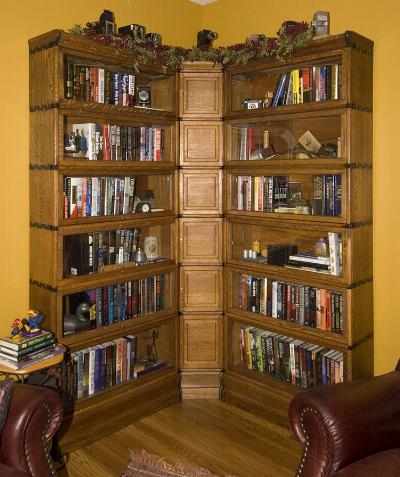
GLOBE WERNICKE CORNER BOOKCASE
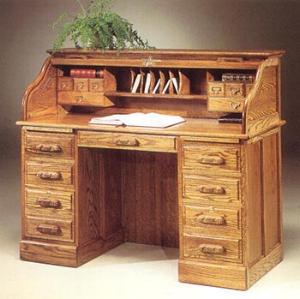
OAK
ROLL TOP DESK
A
solid oak roll-top desk, with oak handles, and fully fitted
interior.
Several
in stock, please EMAIL
for details and prices
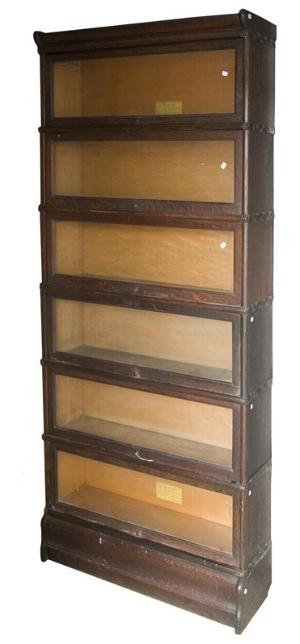
GLOBE
WERNICKE STACKING BOOKCASE
Oak
stacking bookcase, made by Globe Wernicke
Several
in stock, please EMAIL
for details and prices
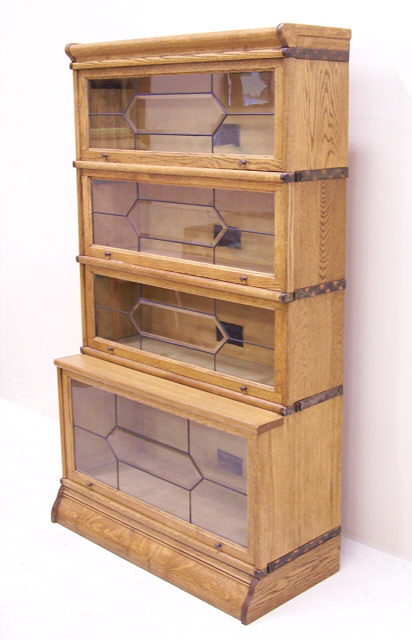
GLOBE
WERNICKE STACKING BOOKCASE
Oak
stacking bookcase, made by Globe Wernicke
Several
in stock, please EMAIL
for details and prices
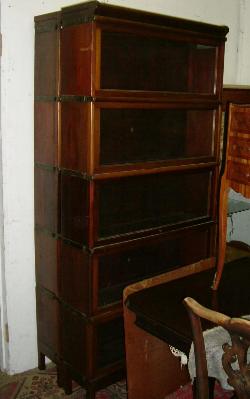
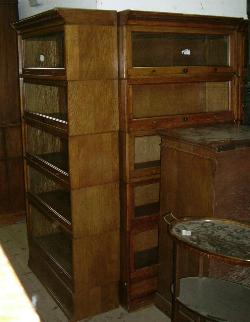
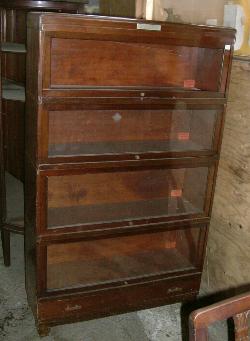
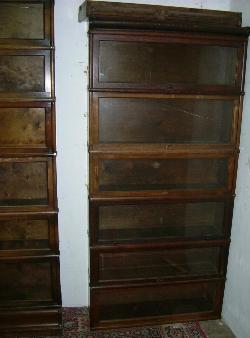
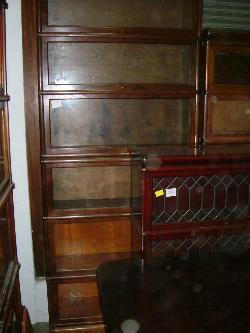
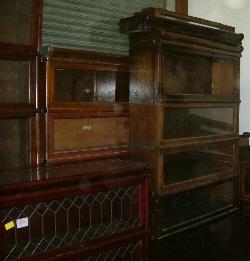
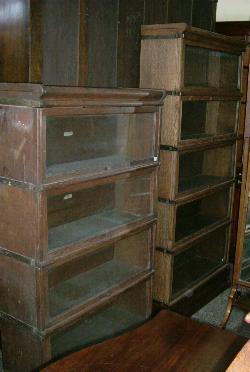
We have Trade Warehouse with a large selection
of unrestored Globe Wernicke Bookcases always in stock...
Please EMAIL
for details
GLOBE
WERNICKE PRICES
Unrestored
£150.00 + VAT per section
Restored
£200.00 + VAT per section
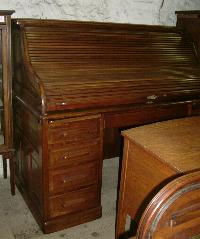
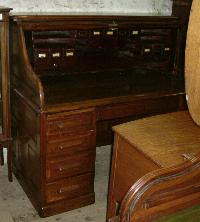
OAK
ROLL TOP DESK PRICES
Unrestored
£1000.00 + VAT
Restored
£1800.00 + VAT
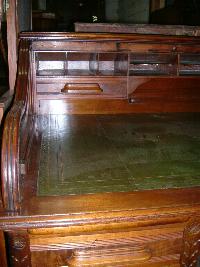
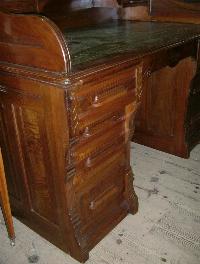
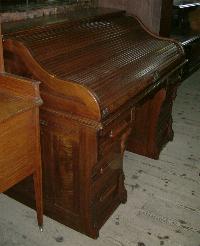
WALNUT
or MAHOGANY ROLL TOP DESK PRICES
Unrestored
£1200.00 + VAT
Restored
£2000.00 + VAT
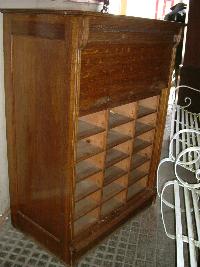

OAK
TAMBOUR OFFICE CABINET PRICES
Unrestored £450.00 +
VAT
Restored £550.00 + VAT
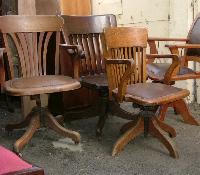
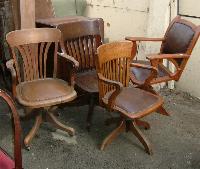
OAK or MAHOGANY VINTAGE OFFICE
CHAIRS
Oak Unrestored £250.00
+ VAT
Oak Restored £350.00
+ VAT
Mahogany Unrestored £350.00
+ VAT
Mahogany Restored £450.00
+ VAT
OAK
FILING CABINET PRICES (4 Drawers)
Unrestored
£250.00 + VAT
Restored
£350.00 + VAT
WE
CAN ARRANGE DELIVERY THROUGHOUT THE UK AND THE WORLD
Wij hebben het Pakhuis van de Handel altijd
met een grote selectie van unrestored Boekenkasten van Wernicke
van de Bol in voorraad... Gelieve TE
VERSTUREN voor details met de elektronische post
Nous avons l'entrepôt commercial
avec un grand choix des bibliothèques non restaurées
de Wernicke de globe toujours en stock... Svp EMAIL
pour des détails
Wir haben Geschäftslager mit einer
großen Vorwähler von unrestored Kugel Wernicke
Bücherregale immer auf Lager... Bitte EMAIL
für Details
Op deze pagina bieden wij een inzameling van zowel antiquiteiten
als replica's voor gebruik in het bureau aan. Wij hebben een
voorraad van het Uitstekende Materiaal van het Bureau, broodje-Hoogste
Bureaus, de Boekenkasten van Wernicke van de Globe, de Boekenkasten
van de Bibliotheek, de Uitstekende Stoelen van het Bureau,
de Uitstekende Klokken van het Bureau, de Uitstekende Lampen
van het Bureau, en de Uitstekende Toebehoren van het Bureau.
Deze voorraad verandert regelmatig, zo tevreden e-mail met
uw vereisten.
À cette page nous offrons une collection des deux
antiquités et reproductions pour l'usage dans le bureau.
Nous avons des actions d'équipement de bureau de cru,
de bureaux de Rouler-Dessus, de bibliothèques de Wernicke
de globe, de bibliothèques de bibliothèque,
de chaises de bureau de cru, d'horloges de bureau de cru,
de lampes de bureau de cru, et d'accessoires de bureau de
cru. Ces actions changent régulièrement, satisfont
ainsi l'email avec vos conditions.
Auf dieser Seite bieten wir eine Ansammlung beider Antiken
und Repliken für Gebrauch im Büro an. Wir haben
einen Vorrat an Weinlese-Büroeinrichtung, Rollen-Oberseite
Schreibtische, Globe Wernicke Bücherregale, Bibliothek-Bücherregale,
Weinlese-Büro-Stühle, Weinlese-Büro-Taktgeber,
Weinlese-Schreibtisch-Lampen und Weinlese-Büro-Zusatzgeräten.
Dieser Vorrat ändert regelmäßig, gefallen
so email mit Ihren Anforderungen.
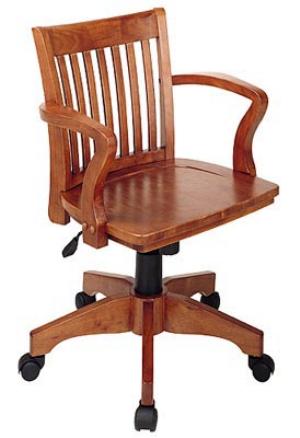
OAK
OFFICE CHAIR
We
have a large selection of antique renovated oak office armchairs.
Several
in stock, please EMAIL
for details and prices
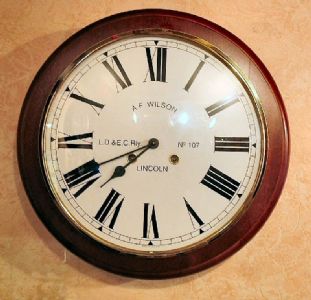
VINTAGE
OFFICE CLOCK
We
have a large selection of early office clocks, including Station
Clocks, Post Office Clocks and Time Card Clocks
Several
in stock, please EMAIL
for details and prices
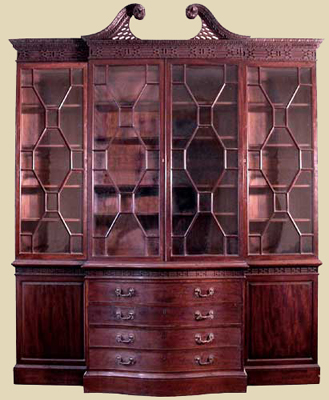
ANTIQUE
LIBRARY BOOKCASE
Always
in stock, Oak Antique Bookcases, Mahogany Antique Bookcases.
Several
in stock, please EMAIL
for details and prices
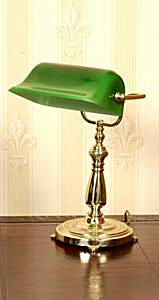
BRASS
BANKER'S LAMP
Replica
brass Banker's Desk Lamp.
Several
in stock, please EMAIL
for details and prices. We also have several antique
desk lamps in stock
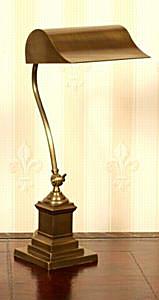
BRASS
OFFICE LAMP
Replica
brass Office Desk Lamp.
Several
in stock, please EMAIL
for details and prices. We also have several antique desk
lamps in stock.
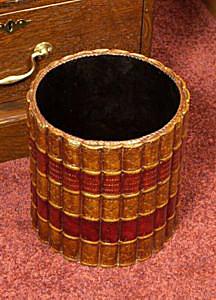
DUMMY
BOOK WASTE PAPER BIN
Several
in stock, please EMAIL
for details and prices.
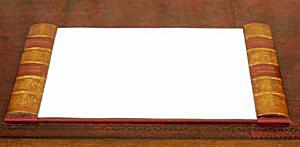
DUMMY
BOOK BLOTTER
Several
in stock, please EMAIL
for details and prices.
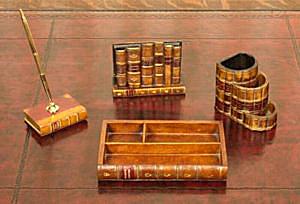
DUMMY
BOOK DESK ACCESORIES
Several
in stock, please EMAIL
for details and prices.
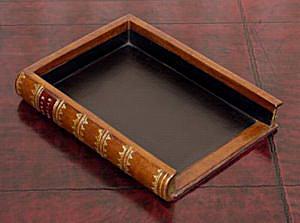
DUMMY
BOOK FILING TRAY
Several
in stock, please EMAIL
for details and prices.
THE HISTORY OF STACKABLE BOOKCASES
An American businessman Henry C. Yeiser set up a furniture
factory called The Globe Files Co in Cincinnati in 1882. The
factory started manufacturing office and filing furniture.
In about the same time, a furniture factory called The Wernicke
Co was set up in Grand Rapids, Michigan. A few years later
The Wernicke Co designed a bookcase, which consisted of different
sized glass cabinet components. By stacking these components
on top of and beside one another, you could create different
wholes.
Henry C. Yeiser got interested in this design and bought
The Wernicke Co factory. With the new owner, the factory was
renamed The Globe Wernicke Co. In December 1892 Henry C. Yeiser
patented this unique bookcase design. This bookcase design
was a huge success and aroused great interest also in Europe.
By the end of the 19th century, an English furniture manufacturer
Thomas Turner started marketing the design in England. The
company was named The Globe Wernicke Co Ltd. In time, The
Globe Wernicke Co also expanded to Canada, France, Belgium
and Austria.
With the designs great success several other furniture manufacturers
got interested in the product and started to manufacture similar
designs. The most notable of these in Europe were: Shannon
Registrator, Minty and Gunn in England; Aug. Zeiss & Co
(later Zeiss Union) and Soennecken in Germany and Lingel in
Hungary.
In Finland, Billnäs Bruk Aktiebolag started manufacturing
American style office furniture in 1909. A significant part
of this product line was the Globe Wernicke bookcase design.
Billnäs Bruk merged with Oy Fiskars Ab on the 1st of
January 1959, but continued to manufacture furniture under
the name Billnäs Bruk. The making of American style office
furniture ended in the late ’60s and the furniture factory
was closed down in 1970. BOKNAS
Otto Heinrich Louis Wernicke in 1889 invented a stacking
system for units, meant as a quick
system of building up storage shelves. The design of this
storage rack - made from bare planks - formed the basis of
the later known Globe-Wernicke bookcase technique. The first
patent for this shelving system was granted in 1892 and not
long after the Wernicke Company, in Norwood, a suburb of Cincinnati
in the USA, emerged. The popularity of the then known Wernicke
bookcase units rose very quickly. With frequent advertising
in the North Western Law Reporter these units were soon given
the nickname the Barrister Bookcases. But notaries, lawyers
and ministers also found the stacking bookcase system an attractive
benefit. In 1899 the company Globe took over the Wernicke
company. The Globe company had already developed to be one
of the largest producers of archive systems, filing cabinets
and pigeon-hole shelving. The company knew that with this
bookshelf system it would create a welcome addition to their
existing portfolio of products. Thanks to the increasing popularity
of the units they could make a start on refining them. Thus
they began using them to hang in window fronts helping prevent
dust and once decorative edging and covered ridging were added
they were also used in reception areas. As a result of this,
the Globe-Wernicke bookshelf system developed a wider market.
ORIGINALITY VERSUS PLAGIARISM
The production of the Globe-Wernicke bookcase units was not
only linked to the USA. In London they also started manufacturing
them and as a result they also became a great success in Victorian
England. Thanks also to the world-wide spread of the British
colonies, people even came across the stackable bookshelves
in India. Successful products are always imitated. After the
first patent expired (after 20 years), the first copies appeared.
This was not only the case in the USA and England, but copies
were also being made in Germany and Scandinavia. A big difference
between these copies and the original Wernicke units was that
the first named copies were limited only to the production
of a few designs. Globe-Wernicke was the only one who supplied
a rich assortment of varying depths, breadths, heights and
styles. Every new product was instantly patented, which meant
the Globe-Wernicke company remained a step ahead of the competition.
It is also thanks to the slogan “It grows with your
business and your business grows with it”, that Globe-Wernicke
grew to be one of the largest factories of its time.
STYLES
Besides the ‘Standard line’ of Globe-Wernicke, there
was also the simpler Universal Style and the luxury Ideal
Unit Bookcase with stained-glass, pilasters on the balusters
and a ridged cover with cut-out acanthus leaves. All cupboards
were delivered in oak and mahogany. What began as simple stackable
shelving units, sometimes turned into a complete library,
with as many partition as corner models in varying sizes.
In adverts, the cupboards were praised with the term “The
Unit Idea”, to help spread the basic concept of the shelving
system. With the luxury Ideal Unit Bookcase - the Rolls Royce
of bookcase systems - Globe- Wernicke in 1912 reached its
highest point. Later, in 1920 sales dropped and Wernicke,
the inventor, died. After a takeover in 1955, the workers
at Norwood handed in their notice and with that the curtain
fell on the Globe-Wernicke company. The end of a company with
a remarkable history and a unique product. But this did not
automatically mean the end of the Globe-Wernicke shelving
system. The opposite in fact.
GLOBE-WERNICKE COLLECTOR
Nowadays it is still possible to make up library shelving
systems with the original Globe-Wernicke units. Due to the
fact that the ceilings since the second half of the last century
have become lower, and standard antique bookcases in most
houses did not fit, the old style shelving system is a good
alternative.
The bookcases are sold in sections and we can look for whatever
colour, grain or size fits best together. Often people divide
two large units as bases, which are then built up with smaller
units of the same size and then finished off with a ridge
round the top.
The original Globe-Wernicke bookcases are available in four
different depths and seven different heights. No other brand
offers this. The cupboards can also be placed under a 90 degree
corner and then paired up, with the help of corner fittings.
Most of the units ordered are requested narrower than the
standard size (86 cm). Bases and ridge-tops are delivered
in the same widths as the cases themselves. The bases are
also available with or without drawers.
In the shop there are varying examples of the many possibilities.
What is unusual about the system is that it can be adapted
to practically any space. Original pieces can always be added
to. Rightly so on all original pieces there is a slogan to
be found which every Globe-Wernicke enthusiast keenly treasures
: “Globe-Wernicke: always complete but never finished.”
THE SYSTEM
The coupling system is the most essential part of the Globe-Wernicke
bookcase systems, where the separated units are built up.
One unit attaches vertically to the other. When linking them
sideways a horizontal joining strip is used. This is constructed
from a metal strip dyed blue which when dried is covered with
copper plating to match the doorknobs and draw handles. Besides
the basic bookcases in oak and mahogany there are combination
bookcase units which are put together by building up sections
with different heights and depths with as many straight as
corner fittings.
Corner fittings are unique because of the fact that old corner
units are nowadays very scarce. What is often used to solve
this corner problem is to attach ridged tops and edging at
a 90 degree angle under the corner joint. If necessary the
corner between the units can be finished off with a cornicing
effect from polished wood.
Each unit of this system comes with a sealed glass door.
Literally in less than no time it can be opened, where after
the door can be pushed up and over the books towards the back
wall with the use of roller bearings which are equipped with
a scissor system. In short: simple to operate and practical
to use.
Glass faceted front hanging doors can be made to order –
and for an extra supplement –delivered. Instead of glass
the front doors can also be ordered with embossed wooden panels.
VAN LEEST.
GLOBE WERNICKE DETAILS
1. Universal Style: The "800" series (809,
811, 813, 847, etc...) - This is the VENEERED sides and "no
Bands" straight and simple design. The veneer on the
sides often cracks and splits and is more difficult to cleanly
repair. The bases have legs, but are not like the mission
style bases, and the tops are squared, but have little accent
in design, keeping with the "clean, simple lines"
design. Generally available in Quartered Oak, Imitation Mahogany,
and Imitation Walnut.
2. Art Mission Style: The "300" series (308,
310, 312, 347, 341, etc...) - This is the solid wood series
with thicker sides and usually wooden bands and wooden knobs,
although there is a line (Mission series) with metal bands
and metal knobs, squared. The bases have legs in the mission
style, and the tops are heavy and squared, also with wood
or metal bands. The "Colonial" and "Art Mission"
styles share the same book sections, but the tags may read
"Colonial" or "Art Mission". The top and
bottom are what distinguishes these styles predominantly.
Generally available in Quartered Oak, Genuine Mahogany, and
Genuine Walnut. Available in "single door" and "double
door" configuration as well. The difference between "Mission"
and "Art Mission" is the bands. The Mission series
having metal bands and metal knobs.
3. Colonial Style: Also the "300" series
(308, 310, 312, 340, 349, etc...) - See the Art Mission description
above. The main difference is the front of the top and base
sections has a rounded appearance and the legs are rounded
in front as well, in the typical colonial style. These seem
to be more rare, and I have not seen any in the metal band
configuration, unlike the mission series. The tops to these
weigh a lot! They are very heavy and solid. Generally available
in Quartered Oak, Genuine Mahogany, and Genuine Walnut. These
are also available in "single door" and "double
door" configurations.
4. Standard Style: The "100" series, and
the "Standard D" and "Standard C" series
(108, 110, 112, 143, D-12 1/4, C-9, etc...) - This is the
most common series seen and sold here on e-Bay. About 34"
wide. Comes standardly in the "D" depth or about
11 1/2" deep or the "C" depth or about 9 1/2"
deep. Also comes in a deeper "E" section about 13"
deep and then the custom, and very rare "G" and
"H" sections. The standard top as well as the standard
base for these has been called by many names; Rolltop, Waterfall,
Ogee, Rounded front. These have metal bands, mostly brass,
some copper as well. Metal knobs, mostly brass, but some copper
as well. Generally available in Plain Oak, Quartered Oak,
Genuine Mahogany, and Imitation Mahogany. Available in "single
door" and "short" configurations in both the
"D" and "C" sizes.
5. Sheraton Style: The "500" series (508,
510, 512, 541, etc...) - This is a fancier style with inlays
on the faces and the sides. These are, like the Universal
style cases, VENEERED sides. These were manufactured only
in real mahogany, as far as I know, and are pretty scarce.
I believe these are meant to be the Cadillac universal style,
so the tops are square and the bases have legs, but not in
the mission style. Generally available only in Genuine Mahogany.
Available in "single door" and "double door"
configurations.
6. Ideal Style: The "400" series (408, 410,
412, 460, 440, 446, etc...) - This is the very fancy set from
GW, the "Top of the Line" series. Panelled sides,
very detailed trim, richly carved fronts. Solid wood for the
most part. These do not have regular glass, but only bevelled
or leaded glass. So, if you are buying one of these sections
and there is regular glass, know that although it may be old
glass, it is not the original glass. The top and base somewhat
rounded like the standard series, but definitely different.
This is a very rare set. Generally available in Quartered
Oak, Genuine Mahogany, and Genuine Walnut. Available in "single
door" configuration.
Globe Wernicke - The CODES:
Pattern Numbers - Reference the above "series"
numbers - There are more numbers than provided, but this are
the most common and they should provide a guide for numbers
not listed.
Grade or Finish numbers -
No. 197 - PLAIN OAK, weathered finish, brass oxidized trimmings
No. 198 - PLAIN OAK, fine medium dark antique gloss finish,
copper oxidized trimmings
No. 217 1/2 - QUARTERED OAK, fumed brownish medium wax finish
No. 297 - QUARTER SAWED FIGURED WEATHERED OAK, dead finish,
brass oxidized trimmings, dark or medium finish available
No. 298 - QUARTER SAWED FIGURED OAK, standard antique finish,
copper oxidized trimmings
No. 298 1/2 - QUARTER SAWED FIGURED OAK, dead antique finish,
dull brush-finished brass trimmings
No. 299 - QUARTER SAWED FIGURED OAK, deep rich golden finish,
highly polished, brass oxidized trimmings
No. 299 1/2 - QUARTER SAWED FIGURED OAK, dead golden finish,
dull brush-finished brass trimmings
No. 398 - IMITATION DARK MAHOGANY, highly polished, brass
oxidized trimmings
N0. 516 1/2 - Genuine MAHOGANY, brownish, dead finish, medium
dark, dull brass hardware
No. 598
- Genuine MAHOGANY, richly finished, medium dark, brass oxidized
trimmings
No. 598
1/2 - Genuine MAHOGANY, medium dark dead finish, dull brush-finished
brass trimmings
No. 599
1/2 - Genuine MAHOGANY, brownish with a tinge of dull red
- Sheraton style only
No. 698
- QUARTER SAWED FIGURED ANTWERP OAK, polished, brass oxidized
trimmings
No. 698
1/2 - QUARTER SAWED FIGURED ANTWERP OAK, dead finish, dull
brush-finished brass trimmings
No. 798
1/2 - QUARTER SAWED FIGURED EARLY ENGLISH OAK, medium light,
dead finish, dull brush-finished brass trimmings
No. 898
- QUARTER SAWED OAK, mission finish, solid brass trimmings
of dull black, furnished on mission style of bookcases only
No. 998
1/2 - QUARTERED OAK, fumed brownish dark wax finish
Author JLent@AtlanticBB.net
ROLL TOP DESKS
Roll Top Desks are part of American History and are a challenging
project to build. In 1850, Abner Cutler, owner of the Cutler
Desk Co. in Buffalo, New York, was the first American to patent
the roll top desk that we know today. The curved tambour top
became his standard and it has become a classic style that
has endured for more than 145 years.
A rolltop desk is a 19th century reworking of the pedestal
desk with, in addition, a series of stacked compartments,
shelves, drawers and nooks in front of the user, much like
the Bureau a gradin or the Carlton house desk. In contrast
to these the compartments and the desktop surface of a rolltop
desk can be covered by means of wooden slats that roll or
slide through slots in the raised sides of the desk. In that,
it is a descendant in function, and partly in form, of the
cylinder desk of the 18th century. It is a relative of the
tambour desk whose slats retract horizontally rather than
vertically.
Unlike the cylinder desk, the rolltop desk could be mass produced
rather easily since the simple wooden slats could be turned
out very fast in a uniform way. In contrast, the wooden section
of a cylinder had to be treated with great pains to keep its
form perfectly over time, lest it warp or bend, and make it
impossible to retract or extend. The wooden slats of the rolltop
were usually joined together by being all attached to a same
cloth or leather foundation, and were thus less influenced
by the problems which plagued the cylinder desk.
The rolltop desk was the mainstay of the small or medium
sized office at the end of the 19th century and the beginning
of the 20th. It gradually fell out of favor with the introduction
of the steel desk and the coming of greater quantities of
correspondence and other documents, which made the small stacked
drawers and small shelves obsolete. There were just too many
letters to bother folding them again and placing them in the
proper slot and there was too little time to open and close
all the small drawers to look for things.
OFFICE CHAIR HISTORY
With the advent of railroads in the mid-1800’s, businesses
began to expand beyond the traditional model of a family business
with little emphasis on administration. Additional administrative
staff was required to keep up with orders, bookkeeping, and
correspondence as businesses expanded their service areas.
While office work was expanding, an awareness of office environments,
technology, and equipment became part of the cultural focus
on increasing productivity. This awareness gave rise to chairs
designed specifically for these new administrative employees
– office chairs.
The office chair was strategically designed to increase the
productivity of clerical employees by making it possible for
them to remain sitting at their desks for long periods of
time. A swiveling chair allowed employees to remain sitting
and yet reach a number of locations within their work area,
eliminating the time and energy expended in standing. The
wooden saddle seat was designed to fit and support the body
of a sitting employee, and the slatted back and armrests provided
additional support to increase the employee’s comfort.
Like our modern chairs, many of these models were somewhat
adjustable to provide the maximum comfort and thus the maximum
working time.
The culture of the office also demanded that a distinct difference
exist between the chairs that the employees used and that
of the chief executive. When swivel chairs were widely used,
the executive sat in a straight-backed chair with no mobility
to demonstrate his status. As design of the office chair eliminated
the arms and added cushioned seats, the executive chair became
a large, upholstered chair with closed arms and wide, luxurious
seats. Even today, the size (both height of the back and width
of the seat) of an office chair demonstrates the status of
the user.
THONET
Michael Thonet (July 2, 1796 - March 3, 1871) was a German
pioneer of furniture design.
Born in Boppard-am-Rhein, Prussia (present day Germany), Thonet
(pronounced TAHN-it) quite fittingly started life near the
beginning of the industrial revolution. He would go on to
form a company and pioneer mass production, both attributes
of this new industrial era.
He trained as an apprentice cabinet maker in his home town.
After his apprenticeship, he began almost immediately to experiment
with bentwood and veneers in furniture. In 1842, Thonet was
invited to Vienna by the Chancellor of Austria to do some
of the furniture for the Palais Liechtenstein. His work was
still very experimental at this point but displayed an innovative
spirit which attracted the Chancellor. Despite being invited
to become the official furniture designer to the throne of
Austria, Thonet chose to remain independent.
He had set his sights on a larger audience. Thonet set up
his own company in the furniture trade, Gebrüder Thonet,
with his five sons and apprentices in the furniture trade
in 1853. By 1856, he had perfected his technique and prepared
for mass production through opening his own factory in Vienna.
He designed the factory himself. Success quickly followed,
so much so that Thonet soon had to open another factory. This
time the factory was located at Koritschan, in the modern
day Czech Republic. This factory was situated close to a large
beechwood forest, as well as a supply of cheap labour. Moreover,
Thonet had streamlined his process even more by this time,
reducing production costs all the way through his process.
The beechwood forest eliminated the need for costly wood importation.
Although Michael Thonet died in 1871, his designs and production
process lived on however, with his sons. By 1913, Gebrüder
Thonet employed 6,400 workers and produced 1.8 million pieces
of furniture a year. One chair, the No. 14 chair alone sold
40 million copies between 1859 and 1939.
Thonet's process of production dictated his furniture design.
Other designers and producers of his time were using flat
wood, with many joints, often ornately hiding the joints through
carving and veneers. Thonet focused his work on bending wood.
Around the early 1840s, Thonet's process was limited. At this
time the only wood bending was used in ship construction.
This involved the application of heat and water while the
piece was secured in a jig. This process was rarely used in
furniture as the wood could not be bent substantially. Thonet
began by using thin wood veneers, which are more flexible
than solid pieces. He would glue several of these together
and place the piece in a jig to dry. This allowed a great
level of flexibility in design, but was labour intensive,
requiring great care while jigging. Thonet was also limited
to bending the wood along only one plane. He experimented
further by cutting the already set veneers in another direction,
and bending them again, as well as varying the dimensions
of the veneers used to try for the maximum in bendablity.
Still, costs were too high, and the process too complex for
mass production. By the mid 1840's Thonet started twisting
his laminated pieces, allowing them to be bent in multiple
directions. The wood then is rasped to give a round or oval
cross section. Once forms were made, this process lead to
the first mass production by Thonet.
Thonet's experiments continued however, both out of an innovating
spirit, and as well as a new economic reason. Thonet's works
began to be exported to the Americas, and it was found that
the glues used in the veneer process were dissolving in hot,
wet tropical climates. After a long period of experimentation,
Thonet discovered the solution. A metal strap was secured
on one side and both ends of a solid piece of wood. Then both
the metal frame and wood were bent as one piece, in a single
operation. The metal strap would stretch marginally, thereby
forcing all the fibers of the wood to compress and not crack.
This solution further streamlined the process, reduced costs,
production time, and opened a new market, all in one move.
Not only did Thonet innovate in his bentwood, but also his
assembly process. Through the use of bentwoods, Thonet eliminated
many of the joints in traditional furniture. This gave greater
strength to the piece using less material, as well as reducing
the amount of fasteners needed. Furthermore, Thonet's furniture
jigs created pieces so accurately time and time again, that
his pieces were interchangeable.
The impact of Thonet was extraordinary and far reaching. Thonet
affected the business of furniture, the avant-garde art establishment,
and the design process of many products, from his own day
to the present. Thonet developed the mass production techniques
of bentwood furniture, but was not the only one to employ
them. Soon after his original patents expired, plenty of imitators
emerged. In the 1890's over 50 bentwood furniture makers were
in business, however none were able to challenge Thonet's
dominance of innovation. As far as production numbers, his
#14 bistro chair remains one of the most produced chairs in
history, still being produced today by Gebrüder Thonet.
With figures like this, his business impact was an amazing
success. Artistically he also impacted greatly. From the art
nouveau appearance of his rocking chairs, to the modernist
simplicity of the #14 bistro chair, he was far ahead of his
time.
Despite the resemblance to later artistic movements, Thonet
allowed his process and market to drive his design, but that
is not to say that these later movements did not draw upon
his work. Auguste Renoir sketched out a Thonet rocking chair
in 1883. Toulouse Lautrec, an art nouveau era artist, used
Thonet furniture in the background of many of his works. Pablo
Picasso had a Thonet in his studio. Finally, the Swiss modernist
architect Le Corbusier used Thonet furniture extensively in
his early buildings, stating how thoroughly they represented
the modernist concepts of economy, durability and humbleness.
In every era to follow, Thonet's work has remained a work
of art, yet also accepted by the mainstream public.
BENTWOOD FURNITURE
Bentwood is a term used to describe furniture made by steaming
wood, bending it, and letting it harden into curved shapes
and patterns, and is most often used in the production of
rocking chairs, cafe chairs, and other light furniture. The
process was developed by Michael Thonet, a German who received
a patent in 1856. Many other furniture manufacturers have
used the process since the expiry of the patent in 1889.
The process is still in widespread use for making casual and
informal furniture of all types, particularly seating and
table forms. It is also a popular technique in the worldwide
production of furniture with frames made of heavy cane, which
is commonly imported into European and Western shops for today's
consumers.
DESKS AND TYPES OF DESK
Armoire desk.
An Armoire desk is a desk built within a large cabinet usually
having the height of a tall man or a small woman, or anything
in between. The cabinet is closed by two to four full height
doors, to keep out dust or give a tidy appearance to a room
by hiding the cluttered working surface of the desk. This
form of desk is usually placed against a wall, like its antique
uncle, the Secretary desk.
Bargueno desk.
The Bargueno (also Vargueno desk) is a desk first produced
in the 15th century that continues to be produced to this
day. The only other desk which is known to have been continuously
produced is the Trestle desk, but some authorities exclude
this desk from consideration because in early times it also
served as a dining table and money lender's counter.
The Bargueno was sometimes used for sewing or as a jewel chest
instead of solely for reading and writing and storing the
necessary implements for these activities.
The Bargueno is above all a Portable desk which resembles
the top half of a fall front desk. It is basically a chest
with its lid on the side, and an interior equipped with a
good quantity of small drawers and pigeon holes.
As a general rule the interior of a Bargueno is much more
richly decorated than the exterior. Thus a Bargueno looking
very plain from the exterior will have a reasonably rich and
well sculpted interior while a Bargueno with impressive exterior
decorations will have a truly ornate and extremely rich interior
with ivory inlays and velvet decoration. It is one of the
best examples of wood craftsmanship in Renaissance Spain.
There was usually a very sturdy iron handle on each side of
the Bargueno, to make transport relatively easy for two strong
servants. A Bargueno could be set down on any solid table
but there were often ready made supports for it: The "Taquillon"
was a chest of drawers decorated much like it while the "Pie
de puente" was a small trestle table also in the same
style and material.
Barguenos first appeared in the 15th and were popular all
through the 16th, 17th and 18th centuries. After a lull in
the 19th century, they became again popular as antiques in
the 20th.
The only other major antique combination of a large portable
desk and a frame is the more delicate and humble Desk on a
frame of the 18th century. It was popular in Colonial America.
Bonheur du jour.
A bonheur du jour is a type of lady's writing-desk, so called
because, when it was introduced in France about 1760, it speedily
became intensely fashionable. The bonheur du jour is always
very light and graceful; its special characteristic is a raised
back, which may form a little cabinet or a nest of drawers,
or may simply be fitted with a mirror. The top, often surrounded
with a chased and gilded bronze gallery, serves for placing
small ornaments. Beneath the writing surface there is usually
a single drawer. The details vary greatly, but the general
characteristics are always traceable. The bonheur du jour
has never been so delicate, so charming, so coquettish as
in the quarter of a century which followed its introduction.
The choicer examples of the time are inlaid with Marquetry,
edged with exotic woods, set in gilded bronze, or enriched
with panels of Oriental lacquer.
Bureau a gradin.
A Bureau a gradin or bureau à gradin is basically an
antique desk form resembling a Writing table with, in addition,
one or several tiers of small drawers and pigeonholes built
on part of the desktop surface. Usually the drawers and pigeonholes
are placed in front of the user but sometimes they can surround
him, or her, as is the case for the Carlton house desk form.
In some cases the bureau a gradin has a second tier of drawers
under the work surface, and thus looks like an advanced form
of the bureau Mazarin or like a non-enclosed version of the
cylinder desk, or the tambour desk.
Bureau plat.
A writing table (French bureau plat) has a series of drawers
directly under the surface of the table, to contain writing
implements, so that it may serve as a desk. Antique versions
have the usual divisions for the inkpot, the blotter and the
sand or powder tray in one of the drawers, and a surface covered
with leather or some other material less hostile to the Quill
or the Fountain pen than simple hard wood.
In form, a writing table is a Pedestal desk without the pedestals,
having legs instead to hold it up. This is why such tables
are sometimes called leg desks.
The writing table is often called a "Bureau plat"
when it is done in a French style such as Louis XVI, Art Nouveau,
etc. When a writing table is supported by two legs instead
of four, it is usually called a Trestle desk.
The writing table is also sometimes called a library table,
because it was often placed in a rich individual's library.
This was the room in a house where a gentleman would keep
literature and also do his business transactions. The library
often housed, in addition, a round desk called a Rent table
and sometimes a Drawing table. The term library table is sometimes
applied indiscriminately to a wide variety of desk forms,
in addition to being used for writing tables. Let the scholar
or the buyer be wary.
Some writing tables have additional drawers built above the
surface. In this case they are often called Bureau a gradin
instead of writing table, unless they have a more specific
form, such as that of a Carlton house desk.
As with many other desk forms antique writing tables were
sometimes built with what was, at the time, a complex mechanism
of gears and levers to make sections slide out or pop up when
certain panels were pulled. In this case one sometimes called
them a Mechanical desk.
Bureau Mazarin.
The bureau Mazarin is a 17th century desk form named more
or less in memory of Cardinal Mazarin, regent of France from
1642 to 1661. It is the earliest predecessor of the pedestal
desk and differs from it by having only two tiers of drawers
or three tiers of rather small drawers under the desktop surface,
followed by eight legs supporting the whole. Also, the bureau
Mazarin has cross braces between the legs, forming two Xs
or two Hs on each side.
Many bureaux Mazarin are kneehole desks, in that they are
meant to be used sideways, with one knee only beneath the
work surface. They were designed in an age where only the
nobility or those who followed its customs closely, could
afford to have such desks made. Members of the nobility often
wore a ceremonial or practical sword, which was forever in
the way. It was thus easier to use a desk sideways, with only
one knee under it. The rest of the space next to the knee
often served as a lockable storage space.
As was often the case with many desks of the period, some
bureaux Mazarin were used as dressing tables instead of serving
as desks, or were used for both functions.
Most of them were built in an ornate style which looks like
a nightmare to keep clean. As with the Kunstschrank of the
lands of Holy Roman Empire, the desk was sometimes more of
a status symbol than a useful piece of furniture.
Carlton house desk.
A Carlton House desk is a specific antique desk form within
the more general bureau a gradin form. This specific form
is supposed to have been designed in the 18th century for
the Prince of Wales (who would later become George IV) by
George Hepplewhite. It is named after Carlton House, which
was at the time the London residence of the Prince of Wales.
This kind of desk is sometimes also known as a Carlton House
writing table.
The desk is like a normal writing table but the small drawers
above the surface form a U shape around the user instead of
being merely set up in front of him as is usual in a typical
bureau a gradin. Unlike other types of bureau a gradin the
Carlton House desk usually offers no pigeonholes.
Drawings of this type of desk were presented by Hepplewhite
in his famous design book the Cabinet Maker and Upholsterers
Guide, and by Thomas Sheraton in his own famous book of designs
(The Cabinet Maker and Upholsterer's Drawing Book), thus ensuring
its popularity.
Carrel desk.
A carrel desk is a small desk (usually) featuring high sides
meant to visually isolate its user from any surroundings either
partially or totally. They were a predecessor to the more
recent cubicle desk.
Carrel desks are most often found in the study spaces of large
universities or college libraries. Most carrel desks are rectangular
in shape and their amenities are often very limited. Above
the main desktop area there is often a shelf for books. Sometimes
the seat is integrated with the carrel desk. Unlike the cubicle
desk, carrel desks usually have no file drawers or other facilities.
Like the school desk, the carrel desk is normally produced
and sold in large quantities for an institutional market.
Cheveret desk.
A Cheveret desk is an antique desk of very small size which
features a single drawer under the writing surface. In some
occasions small drawers and pigeonholes are built on top,
at the back, as in a smaller form of a bureau a gradin. It
is also written with an "S": Sheveret.
Other variants of the Cheveret are much taller and have one
or two shelves built between the legs, under the main drawer.
They are meant to be used standing up, being then a form of
standing desk.
Cheverets were popular in the United Kingdom in the 18th century.
Credenza desk.
A credenza desk is a modern desk form usually placed next
to a wall, as a secondary work surface to that of another
desk, such as a pedestal desk, in a typical executive office.
The credenza desk is sometimes flat, like a pedestal desk,
but more often than not it has a stack of shelves, small drawers
and other nooks, above its main working surface. The sum of
these overhead amenities is usually called a hutch. Hence,
the credenza desk is often called a "credenza with hutch".
The credenza desk is often used as a computer desk, thus leaving
the possibility of keeping the surface of the main desk completely
free, when this is required. An executive desk is often the
central artefact for a meeting between several persons. A
computer monitor or a printer or even a simple keyboard on
the surface can be impediments to the exchange.
The credenza desk is comparable in form to but differs from
the armoire desk in that it is seen for the most part in large
office buildings (instead of home offices, like the armoire
desk) and most of its storage spaces are wide open.
The term credenza is also used for pieces of domestic furniture
such as a sideboard buffet, where food is placed before serving.
Cubicle desk.
A cubicle, cubicle desk or office cubicle is a partially
enclosed workspace, separated from neighbouring workspaces
by partitions, generally five to six feet high. It is partially
or entirely open on one side to allow access. Horizontal work
surfaces are usually suspended from the partitions, as is
shelving, overhead storage, and other amenities.
The term cubicle comes from the Latin cubiculum, for bed chamber.
It was used in English as early as the 15th century. It eventually
came to be used for small chambers of all sorts, and for small
rooms or study spaces with partitions which do not reach to
the ceiling.
Like the older carrel desk, a cubicle seeks to give a degree
of privacy to the user while taking up minimal space in a
large or medium sized room. Like the modular desk of the mid-20th
century, it is composed of modular elements that can be arranged
in various ways with standard hardware or custom fasteners,
depending on the design. Installation is generally performed
by professionals, although some cubicles allow configuration
changes to be performed by users without specific training.
Cubicles are highly configurable, allowing for a variety of
elements such as work surfaces, overhead bins, drawers, and
the like to be installed, depending on the individual user's
needs.
Some sources attribute the introduction of the cubicle desk
to the computer chip manufacturer Intel Inc. during the 1960s.
Its creation is generally attributed to Robert Propst, a designer
from Colorado who worked for Herman Miller Inc., a major manufacturer
of office furniture. It was based on a 1965 prototype and
named the Action Office, made up of modular units with an
open plan, an entirely novel system for the time.
An office filled with cubicles is sometimes called a cube
farm. Although humorous, the phrase usually has negative connotations.
Cube farms are often found in high-tech companies, but they
also crop up in the insurance industry and other service-related
fields. Many cube farms were built during the dotcom boom.
Cylinder desk.
The cylinder desk is a form of desk which resembles a Bureau
Mazarin or a writing table equipped with small stacked shelves
in front of the user's main work surface, and a revolving
cylinder part which comes down to hide and lock up the working
papers when the day is done. Like the rolltop desk which was
invented much later, the cylinder desk usually has a fixed
work surface. This means that unlike a secretary desk the
paperwork does not have to be stored before shutting up the
desk. Some designs however, have the capacity to slide out
the desk surface a few inches to expand the available working
area.
The cylinder desk is also called "bureau Kaunitz",
as it was allegedly introduced in France in the first half
of the 18th century by Wenzel Anton von Kaunitz, then the
ambassador of the Habsburg Empire to the French court. Regardless
of the authenticity of its origin, the French court adopted
this type of desk with great enthusiasm. The difficulty of
producing wooden cylinder sections which would not warp over
the years ensured that such desks were reserved for the rich
and the very rich. A few variants of this form have slats
instead of a one piece cylinder section.
The most famous cylinder desk, and perhaps the most famous
desk of all times is the Bureau du Roi manufactured for the
French royalty in the 18th century.
Davenport desk.
A Davenport desk is a small desk with an inclined lifting
desktop attached with hinges to the back of the body. Lifting
the desktop gives access to a large compartment giving ample
storage space for paper and other writing implements, and
smaller spaces in the forms of small drawers and pigeonholes.
In addition, the Davenport has drawers on one of its sides,
which are sometimes concealed by a panel. This stack of side
drawers holds up the back of the desk and most of its weight.
The front of the desk stands on thick legs or pillars which
are usually carved in a given style.
The shape is very distinctive if not strange. The top part
is much like an antique school desk while the bottom is like
one half of the supports of a pedestal desk turned sideways.
The addition of the two legs in front complete the odd effect.
This desk owes its name to a captain Davenport who was the
first to commission this particular design, from Gillows of
London, near the end of the 18th century. In a sense then
it could also be considered a Campaign desk though there are
no records indicating if the captain was in the British Army
or the Royal Navy.
This desk form was very popular during the 19th century. There
have been numerous reproductions during the 20th century,
and amateur cabinet makers sometimes consider a Davenport
to be an interesting project.
The Davenport desk should not be confused with the Davenport
sofa, which is usually a modern combination sofa and bed or
an antique form of upholstered sofa based on a design conceived
at the beginning of the 20th century by a Boston company called
Irving and Casson and Davenport.
Desk and bench.
A Desk and bench can be an antique or a modern form of desk
combined with a small bench or a stool made in exactly the
same style and material. The desk is usually not very big
and meant to be placed against a wall, in a little room or
a hallway. Because of this intended venue and its small size
it is in a sense a cousin to the Telephone desk. In form it
is in general a smaller brother of the Writing table.
The term "Desk and bench" is also sometimes used
to describe a School desk which has a built-in seat. A "Desk
and bench" set is also sometimes called a "Desk
and stool".
The desk is usually built with a single drawer or none, and
the bench can sometimes have a small storage space under its
seat. Great attention is usually paid to the aesthetics of
the set in order to enhance the matching features.
Since the stool or bench has no back it is put away completely
under the desk when not in use, maximizing even more the available
space.
Desk on a chest.
The Desk on a frame or Desk on frame is usually an antique
form made up of two pieces of furniture. The first piece is
a fairly large and closable portable desk with a slanted hinged
top giving access to the writing surface and utility nooks
and small drawers. The second piece is a stand made for it
in the same style and material. It is also sometimes a single
piece of furniture which looks as if it were made up of the
two previous pieces but is in fact solid and undetachable.
This form was popular in Colonial America and was often done
in the Queen Anne style.
The Slant top desk is a direct morphological descendant. In
a sense the Spanish Bargueno desk or Vargueno is a distant
cousin of the two piece version, since the Bargueno is also
made up of a portable desk and a stand constructed specially
for it, using the same materials and style.
Drawing table.
A drawing board (also drawing table, drafting table, architect's
table or draughting table) is, in its antique form, a kind
of multipurpose Desk which can be used for any kind of drawing,
writing or impromptu sketching on a large sheet of paper or
for reading a large format book or other oversized document
or for drafting precise technical illustrations. The drawing
table used to be a frequent companion to a pedestal desk in
a gentleman's study or private library, during the preindustrial
and early industrial era.
During the Industrial Revolution draftsmanship gradually became
a specialized trade and drawing tables slowly moved out of
the libraries and offices of most gentlemen. They became more
utilitarian and were built of steel and plastic instead of
fine woods and brass.
More recently engineers and draftsmen use the drawing board
for making and modifying drawings on paper with ink or pencil.
Different drawing instruments (set square, protractor, etc.)
are used on it to draw parallel, perpendicular or oblique
lines. There are instruments for drawing circles, arcs, other
curves and symbols too (compass, French curve, stencil, etc).
However, with the gradual introduction of computer aided drafting
and design (CADD or CAD) in the last decades of the 20th century
and the first of the 21st century, the Drawing board is slowly
becoming an obsolete tool.
A drawing table is also sometimes called a Mechanical desk
because, for several centuries most mechanical desks were
drawing tables. Unlike the gadgety mechanical desks of the
second part of the 18th century, however, the mechanical parts
of drawing tables were usually limited to notches, ratchets,
and perhaps a few simple gears, or levers or cogs to elevate
and incline the working surface.
Very often a drawing table could look like a Writing table
or even a pedestal desk when the working surface was set at
the horizontal and the height adjusted to 29 inches, in order
to use it as a "normal" desk. The only give-away
was usually a lip on one of the sides of the desktop. This
lip or edge stopped paper or books from sliding when the surface
was given an angle. It was also sometimes used to hold writing
implements. When the working surface was extended at its full
height, a drawing table could be used as a Standing desk.
Many reproductions have been made and are still being produced
of drawing tables, copying the period styles they were originally
made in during the 18th and 19th centuries.
The expression "Back to the drawing board" is used
when a plan or course of action is unsuccessful and needs
to be changed, often drastically.
Ergonomic desk.
The ergonomic desk is a modern desk form which, like the
adjustable drawing table or drafting table, offers mechanical
adjustments for the placement of its elements in order to
maximize user comfort and efficiency. The ergonomic desk is
usually a "stand-alone" piece of furniture allowing
access to the adjustment mechanisms. Some ergonomic desks
have a sufficiently large desktop height adjustment to create
either a "sit-down" desk or a standing desk, which
allows the user to work while standing. The ergonomic desk
is usually a close companion to the ergonomic chair.
The ergonomic desk originated with the beginning of the field
of human factors or ergonomics after World War II. Legislation
stating minimal requirements for furniture used by office
workers referred to ergonomic desk standards.
The most common form of the computer desk is a variant of
the ergonomic desk, having an adjustable keyboard tray and
sufficient desktop space for handwriting. Provisions for a
monitor shelf and holes for routing cables are integrated
in the design, making it easier to connect the computer components
together. Space is provided for a keyboard, mouse, monitor,
printer and speakers. The typical armoire desk is usually
sold with these features and better cubicle desk designs include
holes, trays and shelves for computer systems.
There is a seemingly endless variety of computer desk shapes
and forms. Large multi-student computer desks configured in
rows are designed to house dozens of computer systems in novel
ways while also facilitating wiring, general maintenance,
theft prevention and vandalism reduction. Small rolling lectern
desks or computer carts with tiny desktops provide just enough
room for a laptop computer and a mouse pad. Computer desks
are typically mass-produced and require some self-assembly.
Local crafts persons can build desks to order or produce unique
designs.
The computer itself is normally separate from the desk. The
desk is designed generically to hold a typically sized computer,
monitor and accessories. Cabling must be carefully routed
through the channels and access openings provided by the desk
design. A few computers are built within a desk made specially
for them, like the British iDesk. The computer is not removable
and cannot be separated from the desk. Office of the future
proposed other integrated designs.
A rolling computer table configuration offers mobility and
improved access in situations where a desk is not convenient.
Gyratory computer tables can be used over a bed. Modular computer
tables separate user interface elements from the computing
and network connection, allowing more placement flexibility.
The modules are connected via wireless technology.
Escritoire.
An escritoire is a small, portable writing desk with a sloping
front door, hinged at the bottom edge, that can be opened
downwards to provide a writing surface. It is usually larger
than a lap desk. The interior may contain small drawers designed
to hold the traditional ink pot, sand container, blotter and
writing feathers or pens. This type of antique appeared in
the 16th century in Europe and was produced in large quantities
in France in the 18th century. Modern reproductions are sometimes
made of this compact desk form.
Fall front desk.
The fall front desk can be considered as the cousin of the
Secretary desk. Both have a main working surface or desktop
which does double duty as a cover to seal up papers and other
items located in small shelves or small drawers placed one
on top of the other in front of the user. Thus, all working
papers, documents and other items have to be stored before
the desk is closed.
Unlike the secretary desk, the fall front desk's desktop panel
is in a perfectly vertical position when in its closed position.
Often, there are no additional shelves or drawers above the
section which is enclosed by the desktop. Thus, the fall front
desk is identical in shape to a Bargueno desk which would
have been placed on a stand of drawers, or more precisely
to the form know as Desk on a chest or as "chest-on chest".
The fall front desk is also called a drop front desk or drop-front
desk, and sometimes also a drop lid desk. Scrutoire and scriptoire
are ancient variations. The secretaire a abattant is a nearly
identical form, but usually in a French style such as Louis
XV, Art Deco, etc.. In the early 19th century Shaker communities
produced a tall and plain variation which is often known as
a "cupboard desk".
Fire screen desk.
The fire screen desk was a very small antique desk meant
to be placed in front of a fireplace to keep a user's feet
warm while he or she was immobile, or nearly so, while writing
letters or literature. This kind of desk was very popular
in prosperous homes in Europe during the 18th century and
slowly disappeared during the 19th, with the gradual introduction
of stoves and central heating.
In order to keep the feet and the calves exposed to the heat
from the fire, the fire screen desk usually had the form of
a miniature writing table or a tiny bureau a gradin, with
just a few drawers beneath the desktop. As its name indicates,
it had a retractable fire screen in the back to protect the
user's relatively exposed face from too much heat from the
fireplace. This was extremely convenient since makeup in those
centuries was often wax based. The screen was usually made
of a pleated or straight piece of heavy fabric, supported
by crossed and sliding metallic supports. Many fire screen
desks have survived the centuries, but the rather flimsy original
screens have long ago wasted away. The metal supports or rods
which extended the screens have fared better. As a result,
when the rods are in their extended position, without the
original screen which they supported, they make the fire screen
desk look like some archaic form of radio, with an X shaped
antenna.
A few fire screen desks had no screen per se but were simply
lighter, narrower, and extremely thinner versions of the high
secretary desk put on some form of permanent trestle mount.
Their high form shielded the user's face from the heat of
the flames while the open trestle mount at the bottom exposed
the feet. They were basically a smaller version of a French
form called Secretaire en portefeuille.
Often, the fire screen desk was gendered. One did not buy
or ask for a fire screen desk to be made: One asked for a
gentleman's fire screen desk or a lady's fire screen desk.
The masculine desk was slightly heavier and plainer. The feminine
desk was much smaller (light enough to be transported easily
by a lady's maid) and the ornamentation could be quite complex.
The fire screen desk was also called a screen writing table,
or a gentleman's screen writing table or a lady's screen writing
table.
Lap desk.
As an antique the lap desk is a smaller variant of the writing
slope. It is also called a writing box or a writing cabinet.
In certain instances it is known as a portable desk, a term
which is usually applied to larger forms. Most antique lap
desks are really meant to be used on a table or some other
stable surface. They are often strongly built of fine hardwoods
like mahogany or walnut.
They were, in effect, the fore-times equivalent of a PDA --
that is, they supplied, to the traveller, many of the conveniences
of carrying round an entire escritoire. From them has come
the concept of the briefcase not just as a carrier for papers,
but as a portable writing place; and thus the laptop computer.
As a modern form the lap desk is meant primarily for use in
bed and other similar circumstances. It is also known as a
bed desk. There is a wide variety of forms available, but
as a rule it is much smaller and simpler than the antique
lap desk, having at the most a small drawer or holding area
for a ballpoint pen and a pencil. It is also made of much
cheaper materials, save for a few craft productions.
Certain lap desks have a removable monopod, which makes them
collapsible cousins to the lectern desk. Others have two short
collapsible legs, so that they can be used both in bed and
on a lap, when the legs are folded. Finally, some come with
a built-in battery powered lamp, continuing the tradition
of those antique lap desks and writing slopes which had swinging
or hinged brass candle holders built in.
Most modern lap desks are considered specialty items and very
few furniture dealers keep them in stock. They are present,
however, in a large number of catalogues and on some commercial
Web sites.
Lectern desk.
The antique is basically a lectern fitted with the conveniences
needed to make writing easy, such as room for paper and writing
implements. In a sense, it is a specialised and rarer form
of standing desk. The term is sometimes used to describe large
standing desks instead of "standing desk".
Because the antique lectern desk is smaller than most kinds
of standing desks it is suitable for writing in cramped quarters,
in a residence or at a workplace. Most lectern desks have
a slanted top with a lip, to keep pens and paper from sliding
down.
Liseuse desk.
A Liseuse desk is a medium sized writing table with a small
hinged panel in the middle which can spring up by the aid
of a mechanism or be propped up at a desired angle to facilitate
reading, or writing on its slanted surface. Many have lateral
panels which swing out on both sides to give a larger desk
surface.
The name comes from "liseuse" which is the feminine
form of "liseur" in French. This is often translated
as "reader" but it is used normally to describe
a person which really likes to read, while a simple reader
is called "lecteur" or "lectrice" in the
feminine gender. This is one indication of many of the original
market for such desks.
The Liseuse is an antique desk form which was popular in France
during the 18th century and produced again in the first part
of the 19th century. It was copied in several continental
countries and in the United Kingdom.
Many Liseuses are polyvalent pieces of furniture with a double
or triple use. Geared towards an 18th century feminine market
for the most part, they often have drawers made specially
for storing toiletry and cosmetics in addition to the drawer
or drawers containing paper, quill, ink and other writing
implements.
Moore desk.
The "Moore Office Queen" is a massive desk, made
for a sitting user. From the outside it looks, when closed,
much like its competitor, the Wooton desk but it differs from
it in several ways. For one, it has but a single large door
to lock up the main work surface and the drawers and nooks
around it, while the Wooton has two. More importantly (the
manufacturer liked to boast about it) the main work surface
slides in and out of the main body of the desk so that work
can be stopped and the desk closed without having to put away
everything, as is the case for the Wooton desk.
The "Moore Office Queen" was patented in 1878 in
Indiana in the United States by the Moore Combination Desk
Company.
The Office Queen has a modern descendant called the Armoire
desk.
The "Moore Insurance Desk" is nearly twice as big
as the "Office Queen" and combines a Standing desk
and a normal "sitting" desk in a single piece of
furniture. It was patented in 1882. Like the "Office
Queen" it opens up by means of a single large door, and
its internal work surface slides in and out. But it also has
an external work surface to accommodate a standing user, on
the other side of the desk. The standing user employs the
"roof" of the desk of the sitting user as his (or
her) work surface.
Partners desk.
A partners desk is an antique desk form which is basically
two pedestal desks constructed from the start as one big desk
joined at the front, for two users working while facing each
other. The spelling of the term is irregular, with partner's
desk and partners' desk being common variants.
This massive piece of furniture was first conceived in the
United Kingdom to accommodate the work of banking partners.
These gentlemen were usually senior bank officials who wished
to do teamwork while keeping the convenience and the prestige
of a pedestal desk.
It was an adaptation of the earlier and sometimes more massive
library desk, found in the libraries of the mansions of the
gentry and the nobility.
Most partners desks made in the 19th century were built of
high quality woods such as oak, mahogany or walnut and finished
with tooled leather inserts on top and brass fittings all
around. Many reproductions have been made in the 20th century.
Pedestal desk.
A pedestal desk is usually a large free-standing desk made
of a simple rectangular working surface resting on two pedestals
or small cabinets of stacked drawers of one or two sizes,
with plinths around the bases. Often, there is also a central
large drawer above the legs and knees of the user. Sometimes,
especially in the 19th century and modern examples, a "modesty
panel" is placed in front, between the pedestals, to
hide the legs and knees of the user from anyone else sitting
or standing in front. This variation is sometimes called a
"panel desk". The smaller and older pedestal desks
with such a panel are sometimes called kneehole desks, and
were usually placed against a wall.
From the mid-18th century onwards, a pedestal desk often has
a top that is inlaid with a large panel of leather (sometimes
with a gold- or blind-stamped border) or baize for a writing
surface, within a cross-banded border. If the desk has a wooden
top surface, it may have a pull-out lined writing drawer,
or the pull-out may be fitted with a folding horse to serve
as a bookrest.
Very few non-specialists call this form a pedestal desk. Most
people usually refer to it as an executive desk, in contrast
with the cubicle desk which is assigned to those who work
under the executive. However, the term executive desk has
been applied to so many desk forms as to be misleading, so
the less-used but more precise "pedestal desk" has
been retained here.
The pedestal desk appeared, especially in England, in the
18th century but became popular in the 19th and the 20th,
overtaking the variants of the secretary desk and the writing
table in sheer numbers. The French stayed faithful to the
writing table or bureau plat ("flat desk"), which
might have a matching paper-case (cartonnier) that stood upon
it.
There were at least two precursors to the pedestal desk: The
French Bureau Mazarin (a desk named for Cardinal Mazarin)
of the late 17th century and the Chinese Jumu desk or scholar's
desk, which Europeans knew almost entirely at second-hand,
largely from illustrations on porcelain. Unlike the pedestal
desk however these precursors had an incomplete stack of drawers
and compartments holding up the two ends. The cases of drawers
were raised about 6 to 12 inches from the floor on legs.
When a pedestal desk is doubled in size to form a nearly square
working surface, and drawers are put on both sides to accommodate
two users at the same time, it becomes a partners desk. Thomas
Chippendale gives designs for such tables, which were generally
used in libraries, as writing tables in The Gentleman and
Cabinet-Maker's Director (1753-4 and 1762).
When the pedestal desk form is cut to about two thirds of
its normal width, and one of the pedestals is replaced by
legs, this is then called a right pedestal desk or a left
pedestal desk, depending on the position of the pedestal.
This kind of form is common for a student desk.
The pedestal desk is also one of the two principal forms of
the big campaign desk, used by the military in days gone by.
It can then be considered a portable desk in a limited way
since the writing surface could be easily separated from the
pedestals, to facilitate transport. The three separate elements
were often fitted with large handles on the sides.
Plantation desk.
A Plantation desk is an antique desk form. It is thought
to have been originally used as a mail desk by postmen. The
form has been known to have been used on Southern plantations
in the United States, but it is not limited to them. For some
time communities of Shakers in New England built a large version
of this form of desk. It was quite popular in the 19th century.
Basically, the Plantation desk is a Fall front desk with a
deeper stand or bottom part. The extra space or ledge of the
bottom part of the desk serves as a support for the fall front,
thus eliminating the need for retractable supports. Like a
normal fall front desk the work surface must be cleared of
all materials in order to raise it in a vertical position
and thus close off the small drawers and pigeonholes set in
front of the user.
While the fall front desk evolved from placing a chest, on
its side, on a stand made for it, to its exact dimensions,
as is the case with the Bargueno desk, the plantation desk
form was born by placing such a chest, on its side, on a table
a bit too deep for it. The fall front usually settles at a
slight angle once it is open, in order to give a slanted work
surface to the user.
Some plantation desks have two panel doors instead of a fall
front and the ledge is hence much deeper since it serves as
the main desktop surface.
Rolltop desk.
A rolltop desk is a 19th century reworking of the pedestal
desk with, in addition, a series of stacked compartments,
shelves, drawers and nooks in front of the user, much like
the Bureau a gradin or the Carlton house desk. In contrast
to these the compartments and the desktop surface of a rolltop
desk can be covered by means of wooden slats that roll or
slide through slots in the raised sides of the desk. In that,
it is a descendant in function, and partly in form, of the
cylinder desk of the 18th century. It is a relative of the
tambour desk whose slats retract horizontally rather than
vertically.
Unlike the cylinder desk, the rolltop desk could be mass produced
rather easily since the simple wooden slats could be turned
out very fast in a uniform way. In contrast, the wooden section
of a cylinder had to be treated with great pains to keep its
form perfectly over time, lest it warp or bend, and make it
impossible to retract or extend. The wooden slats of the rolltop
were usually joined together by being all attached to a same
cloth or leather foundation, and were thus less influenced
by the problems which plagued the cylinder desk.
The rolltop desk was the mainstay of the small or medium sized
office at the end of the 19th century and the beginning of
the 20th. It gradually fell out of favor with the introduction
of the steel desk and the coming of greater quantities of
correspondence and other documents, which made the small stacked
drawers and small shelves obsolete. There were just too many
letters to bother folding them again and placing them in the
proper slot and there was too little time to open and close
all the small drawers to look for things.
Because it was produced in vast numbers and at varying levels
of quality, the rolltop desk is popular in the antique market.
It is also popular amongst set decorators who want to recreate
the "ambiance" of an office at the turn of the previous
two centuries, or during famous eras like prohibition. The
rolltop has starred in many plays and movies, the most famous
one being probably a movie titled His Girl Friday with Cary
Grant and Rosalind Russell.
Secretaire en portefeuille.
The Secretaire en portefeuille breaks all records for slimness
in desks and perhaps even in all furniture. It is an antique
desk form which is usually mounted on rollers at the end of
four jutting legs. The legs in turn support what looks like
an oversize vertically mounted wooden pizza box. This is a
cabinet a few inches thick, with barely enough space in it
for the raised desktop surface and a few pens and sheets of
paper disposed vertically.
In short, the secretaire en portefeuille is much like a Fall
front desk which would have been reduced in depth to a bare
minimum. Like the Fall front desk and the Secretary desk the
secretaire en portefeuille's desktop lifts up to cover internal
areas and must thus be cleared of all work before closing
up. By its mobile nature and its relatively light weight it
was sometimes used as a Fire screen desk.It was also sometimes
known by that name.
Its name comes from the French word for wallet: Portefeuille.
This is probably because it has the same proportions as many
kinds of wallets and it opens up a bit like some of them.
Modern day cabinet makers and furniture designers have sometimes
created contemporary versions of the secretaire en portefeuille,
eschewing the florid designs of the antique ones.
Secretary desk.
A secretary desk is made of a base of wide drawers topped
by a desk with a hinged desktop surface, which is in turn
topped by a bookcase usually closed with a pair of doors,
often made of glass. The whole is usually a single, tall and
heavy piece of furniture, not meant to be disassembled after
manufacture, no matter what problems might be incurred in
moving it from point A to B.
Like the slant top desk the main work surface is a hinged
piece of wood which lifts up to a vertical position and is
tilted to an angle of about 45 degrees or so towards the bulk
of the desk in order to enclose secondary work surfaces such
as small shelves, small drawers and nooks stacked in front
of the user. Thus, like the Wooton desk, the fall front desk
and others with a hinged desktop, and unlike closable desks
with an unmovable desktop like the rolltop desk or the cylinder
desk all documents and various items must be removed from
the work surface before closing up.
To those not used to it, the secretary desk looks like a mutant
made up of a mix between a commode-dresser, a slant top desk
and a book case. Many however are used to it since it is one
of the most common antique desk forms and it has been endlessly
reproduced and copied for home use in the last hundred years.
Among home desk forms, it is the tallest, biggest and heaviest
of all, if we exclude wall units and modular desks which can
be disassembled for moving, or some of the biggest of the
armoire desks, which are usually delivered unassembled.
The correct or the most common correct term for the secretary
desk described here, is the secretary and bookcase. Unfortunately
there is no unanimity on this term, even among specialists.
In Europe the same piece of funiture has been called bureau
and bookcase and then desk and bookcase. Also, the general
public usually calls this kind of desk a secretary, or secretaire.
In a taxonomic sense one could sometimes say that all desks
which have the capacity to close off the working surface are
secretaries, while all others are simply desks, but such a
division would be too broad to be useful. To add to the confusion
certain forms of the secretary desk are called escritoire,
usually when the bookcase section is covered with glazed panels
instead of wooden doors, but the term escritoire is also sometimes
used to define a very portable Writing slope, which is it
at the other extreme in terms of bulk and weight.
When a secretary desk is cut in half vertically, so to speak,
to provide a secretary desk half as wide as usual on one side
and a glassed door cabinet on the other, this big piece of
furniture is called a side by side secretary. The term is
also applied sometimes to very big pieces of furniture made
up of three elements, one of them being a half wide secretary
desk. Until recently there was a good example of a side by
side secretary in the second floor office of the historic
home of John Muir in Martinez, California, U.S.A.. The attic
of this home also had a good example of a Portable desk.
On most antique secretaries and also on most reproductions
the user has to pull out two small wooden planks called sliders
in order to support the desktop, before actually turning the
desktop from its closed, angled, position to its normal horizontal
working position. However, in quite a few of the antique versions
a system of internal gears and/or or levers connected both
to the sliders and the hinged desktop automatically pushed
the sliders out at the same time as the user pulled on the
closed desktop to put it in its horizontal position. When
the user closed it afterwards, the sliders would then retract
automatically. In such a case, the secretary is also known
as a Mechanical desk like many other desk forms which have
some sort of mechanism pushing out elements of the desk and
then pulling them back in automatically.
A secretary desk is generally not used by a person with the
title of secretary, since this kind of desk is an antique
form which is now extremely rare in the modern office, where
a secretary (frequently called an administrative assistant)
normally works.
Slant top desk.
The slant top desk can be considered in some ways as the
ancestor or the little brother, of the secretary desk for
it is for all practical purposes a secretary desk without
the massive bookcase on top of it. It can also be considered
as the descendant, in form, of the desk on a frame, which
was a form of portable desk in earlier eras.
In some places the slant top desk is known as a "bureau"
desk, and in others it goes under the name of slope-front
desk. In the United States, the slant top desk is sometimes
called a Governor Winthrop desk, in memory of John Winthrop,
the 17th century governor of the Massachusetts Bay Colony.
The slant top desk is also called a slant front desk.
Like the Wooton desk, the fall front desk and others with
a hinged desktop (and unlike closable desks with an unmovable
desktop like the rolltop desk or the cylinder desk) all documents
and various items must be removed from the work surface of
the slant-top desk before closing up.
The slant-top desk has been handcrafted in a variety of styles,
the most famous being probably the block front seashell desk
of the 18th century which was popular among the well-to-do
of Colonial America.
The slant-top desk has also been mass produced in a great
quantity of sub-forms and materials. For instance, some slant
top desks have very crude chains or levers to hold the desktop
in an open working position, while others have elegant sliders
which are manually or automatically extended to give support.
Spinet desk.
A spinet desk is an antique desk form which has the exterior
shape of a slightly higher than usual writing table, fitted
with a single drawer under the whole length of the flat top
surface. The spinet desk is so named because when closed it
resembles a spinet, a musical instrument of the harpsichord
family.
This single drawer, however, is a dummy. It is a hinged panel
which is meant to be folded in, at the same time as half of
the hinged top surface is folded back on to the top of the
other half, revealing an inner desktop surface of normal height,
with small drawers and pigeonholes in the back. In certain
spinet desks the inner desktop surface can be drawn out a
few inches, adding working space.
The image of the front of the spinet desk shows it in a closed
position while the image of the side shows it in a partly
open position, just before the hinged mobile part of the top
is placed on the fixed part of the top.
By this capacity of hiding or revealing the main working area
the spinet desk could be said to be a smaller, less obtrusive
cousin of the rolltop desk and the cylinder desk. Like them,
and unlike the secretary desk or the fall front desk, it can
be closed up without disturbing too much the paperwork and
various documents and implements left on the main desktop
surface.
Standing desk.
A standing desk is both an antique desk and a modern desk
form conceived for writing and/or reading while standing up
or while sitting on a high stool. The term stand-up or stand
up desk is also used. Standing desks were popular in the homes
and offices of the rich, during the 18th century and much
of the 19th.
While most modern desks are 30 inches (76 cm.) high and most
antique desks 29 inches high (73.7 cm), there is no such average
for standing desks. Users of a "sitting desk" are
fairly immobile so it is relatively easy to adjust the height
of a seat to compensate for variations in the individual height
of the users. Users of a standing desk move around a bit more,
so it is not practical to have them stand on a small pedestal
or some other object. Thus, standing desks tend to vary greatly
in height.
It was common in the past to have a standing desk made to
measure to the height of the user, since only the rich could
afford desks. One way to go around this problem a bit, when
one had many users for a single desk, was to give an angle
or slant to the writing surface, as was common on the typical
drawing table. The other alternative, to produce a desk with
adjustable legs, was less popular, but it was frequent enough
to give birth to a precise desk form, the "table à
tronchin" or "table à la tronchin".
The modern solution is presently found in the ergonomic standing
desk, which can be adjusted to the height of most standing
persons, and offers other possible adjustments, as is the
case for a typical ergonomic desk.
Manufacturers of fixed height standing desks and ergonomic
standing desks point to several studies showing reduced back
injuries or less back pain for the users of standing desks.
Most standing desks have an open frame with few or little
drawers, and a footrail (similar to those seen at a bar) to
reduce back pain. It is more practical to make a hinged desktop
which can be lifted to give access to a small cabinet placed
underneath it, despite the problems this layout can cause
to objects left on it. This way the user can store or retrieve
papers and writing implements without bending or standing
back from the desk.
There are many specialized standing desks such as certain
variations of the telephone desk and certain types of wall
mounted desks.
Tambour desk.
A tambour desk is a desk with desktop-based drawers and pigeonholes,
in a way resembling a bit that of a bureau a gradin. The small
drawers and nooks are covered, when required, by reeded or
slatted shutters which usually retract in the two sides, left
and right. It is a flatter and "sideways" version
of the rolltop desk.
Unlike the rolltop desk, the tambour desk uses straight, perfectly
vertical rows of shutters, and the work surface rests on a
few drawers, which in turn are supported by short legs instead
of pedestals. In addition, half of the desktop folds back
on itself when not in use. The desktop is supported by sliders,
like a secretary desk or a slant top desk when it is unfolded.
The tambour desk is an antique form indigenous to the United
States of America, and should not be confused with the British
Tambour writing table.
Telephone desk.
The telephone desk is the smallest kind of fixed desk. Its
traditional role is to provide a working surface barely large
enough to write notes while speaking on the telephone, and
in some cases to support the telephone and maybe hold telephone
books. In early generations of telephones the phone apparatus
itself had a small desk built-in. This was most common in
wall mounted telephones of the end of the 19th and the beginning
of the 20th century.
The original illustrations done for this article show front
and side views of such an antique wall phone with a small
slanted desk surface fitted with two ridges to keep paper
and pencil from falling to the floor.
The telephone desk has usually been a domestic piece of furniture.
In an office a telephone would normally be placed on any form
of desk, as close as possible to its users.
In the last 50 years of the 20th century a domestic telephone
desk would usually be placed next to a phone located in an
entryway or a small lobby. The telephone desk is rapidly becoming
an antique form, with the widespread use of the cellular telephone,
and the portable phone, which permit complete liberty of movement
and make note-taking possible on any table or desk in a home.
In the past any telephone booth or call box used to have a
tiny built-in desk surface for the convenience of customers.
An increase in vandalism and a higher concern for costs has
led to the gradual elimination of these minuscule desk surfaces.
Trestle desk.
The antique trestle desk is usually very much like the Writing
table desk form, which offers a simple flat desktop surface
with a few drawers underneath it. Unlike the writing table
the trestle desk is supported by two legs instead of four,
and the legs are designed to be dismantled easily in order
to store or move the desk efficiently. More precisely, the
two legs are two strong side supports which branch out in
two feet each (for a total of four) at the bottom.
Some antique trestle desks are fitted with small cubby holes
and nooks or small drawers at the extremity of the work surface,
and thus resemble a Bureau a gradin.
As with most antique desk forms, this trestle desk surface
is usually 29 inches (73.7 cm) from the floor.
Typewriter desk.
A Typewriter desk is an antique desk form meant to hold a
typewriter in an efficient position for the typist. This position
is usually a few inches lower than the 29 inch (73.7 cm) height
of the typical antique desktop.
The first generations of typewriters, in the last 25 years
of the 19th century and the first decades of the 20th, spurred
the invention and production of a great number of forms of
typewriter desks.
All of the early typewriter desks were extremely sturdy affairs
since the early typewriters were not electric and could be
operated only by constant pounding on the keys by the user.
The pounding could have gradually destroyed several traditional
desks.
The early typewriter desks often had in common some form of
device or method for hiding the typewriter or getting it out
of the way within the desk, by swivelling it or turning it.
In those days typewriters were very costly machines which
one tried to protect from dust or accidents . They were also
very ungainly or eve
n ugly to those unfamiliar with them, and getting them out
of sight was useful for aesthetic reasons.
After World War I typewriters gradually became less costly
and the typewriter desk was more or less standardised in two
forms: One was a small mobile desk incorporating four wheels
with brakes, the other was an "L" shaped desk with
a "normal" height section for reading and handwriting
and a lower section for the typewriter.
Wooton desk.
The Wooton desk is a variation of the Fall front desk. It
is the embodiment (in the field of desk design and construction)
of the phenomenon of conspicuous consumption which swept over
moneyed society in the United States at the end of the 19th
and the beginning of the 20th century, and was described by
Thorstein Veblen in his book The Theory of the Leisure Class.
Wooton desks were probably not the costliest desks in series
production, but they were possibly the ones with the most
drawers, nooks and crannies imaginable. Only a few examples
of the Cupboard desk had more divisions, but they were of
a very utilitarian different style, and were often produced
by the very families or communities which used them, such
as the Shakers. The Armoire desk is the closest modern relative
to the Wooton desk in its size and form. But the armoire desk
is even bigger and larger than the Wooton, and despite the
use of rich veneers by some makers, it is a much more practical
piece of furniture.
An Indianapolis, Indiana entrepreneur (who was later to become
a Protestant preacher) called William S. Wooton obtained patents
for his design and established a company in 1870. Production
continued till about 1884.
The Wooton desk which is the subject of this article is their
better known secretary desk. The Wooton desk company also
produced a so-called rotary desk, which is in fact a pedestal
desk whose pedestals have segments which turn on themselves
to expose more drawers and nooks.
The Wooton secretary desk usually rests on a four legged quadruped
support equipped with casters. The main body of the desk is
filled with a dozen or several dozens (depending on the model)
of small drawers and nooks for papers and small objects.
As in a "secretaire a abattant" or in a Fall front
desk the main working surface or desktop is hinged and lifted
completely from the horizontal to the vertical in order to
lock up the desk, forcing the user to gather up and store
all papers and implements beforehand. Unlike the secretaire
a abattant however, the Wooton desktop hides only a few of
the small drawers and nooks. The real lockup is done by closing
two massive hinged panels which are themselves as deep as
the desk and are like it filled with small drawers and nooks
of all sizes.
The Wooton desk was introduced at the end of the 19th century,
at a time when office work was changing in a drastic fashion
with an increase in paperwork that led to the introduction
of filing cabinets, among other things. The white-collar worker
invaded the office in huge numbers. The new reservoir based
fountain pen and the typewriter were used to produce greater
quantities of office documents than ever before. In this context
desks which required users to fold and title each letter or
document and place it in a pigeon hole, or small nook, were
simply not efficient. It was faster to place an unfolded piece
of paper in a folder and place the folder in a file cabinet
or file drawer.
In a sense the Wooton desk was obsolete just as it was born
and its biggest selling point was probably snob appeal in
owning a complex desk with so many divisions and an abundance
of ornaments.
Wooton desks in good condition are sometimes sold in auctions
for the same price as a top of the line luxury automobile.
Writing armchair.
The Writing armchair has an antique and a modern form. In
its antique form it is known as a writing armchair in the
United States and as a tablet armchair in the United Kingdom.
It is more often than not a Windsor style armchair with a
circular or oval pad or tablet replacing the right arm or
mounted above it. Many versions have a drawer built under
the pad, to hold writing implements. Other versions have such
a drawer under the seat.
On some versions the pad is on a hinge, in order to fold it
down and facilitate storage, or simply take up less space
in a room. In this case it is often called a drop leaf chair,
and becomes a close cousin to the mechanical desk.
In its modern form it is, most of the time, the most compact
rendition of a school desk or a student desk, and it is manufactured
by the millions in metal and plastic. It is available in a
very wide variety of sizes to suit the changing needs of growing
children. It also differs from the antique form by being relatively
ambidextrous: The tablet or pad is available for the right
arm or the left arm, to also suit those who write with their
left hand. Unlike the antique form the arm with no pad is
usually completely absent, to ease entry in the chair in the
crowded conditions of a schoolroom or lecture hall.
Modern designers have offered several contemporary renditions
of the writing armchair or the drop leaf chair, but the form
has never been very popular in homes.
Writing desk.
A writing desk is a sort of compact office. It has a top
that closes to hide current work, make the room look neat,
maintain privacy and protect the work. Traditionally, they
are for writing letters by hand, but, of course, modern ones
are designed for lap-top computers. They are typically too
small for most desk-top computers. The closing top may have
joints and roll, or may simply fold closed. The writing surface
(or place for lap-top) typically folds down (perhaps being
the lid) or slides out, to preserve the compact size when
closed. They often have small drawers or "pigeon holes".
Writing table.
A writing table (French bureau plat) has a series of drawers
directly under the surface of the table, to contain writing
implements, so that it may serve as a desk. Antique versions
have the usual divisions for the inkpot, the blotter and the
sand or powder tray in one of the drawers, and a surface covered
with leather or some other material less hostile to the Quill
or the Fountain pen than simple hard wood.
In form, a writing table is a Pedestal desk without the pedestals,
having legs instead to hold it up. This is why such tables
are sometimes called leg desks.
The writing table is often called a "Bureau plat"
when it is done in a French style such as Louis XVI, Art Nouveau,
etc. When a writing table is supported by two legs instead
of four, it is usually called a Trestle desk.
The writing table is also sometimes called a library table,
because it was often placed in a rich individual's library.
This was the room in a house where a gentleman would keep
literature and also do his business transactions. The library
often housed, in addition, a round desk called a Rent table
and sometimes a Drawing table. The term library table is sometimes
applied indiscriminately to a wide variety of desk forms,
in addition to being used for writing tables. Let the scholar
or the buyer be wary.
Some writing tables have additional drawers built above the
surface. In this case they are often called Bureau a gradin
instead of writing table, unless they have a more specific
form, such as that of a Carlton house desk.
As with many other desk forms antique writing tables were
sometimes built with what was, at the time, a complex mechanism
of gears and levers to make sections slide out or pop up when
certain panels were pulled. In this case one sometimes called
them a Mechanical desk.
Campaign desk.
A Campaign desk is an antique desk of normal size which was
used by officers and their staffs in rear areas during a military
campaign.
The campaign desk was usually the private property of the
officer, as was his uniform and other military implements.
It was in general handcrafted by a master cabinet maker according
to the officer's wishes or following traditions for such desks.
The desk forms varied greatly, but nearly all had as a common
trait several features which made it easy to transport them
from one campaign posting to another.
For instance, a campaign desk version of a traditional pedestal
desk form would have strong but removable fittings making
it easy to break up the desk in three pieces: Two pedestals
and one desktop surface. Each piece would have brass or iron
handles mounted on it to facilitate handling.
Campaign desk variations of the antique Writing table seem
to have been rather frequent. This form was usually in one
piece, with strong handles and two pairs of foldable legs.
A smaller version of such a transportable writing table could
be considered to be more a field desk than a campaign desk,
since it could be moved frequently from one battlefield's
rear area to another's as the war went on.
Any campaign desk is in a sense also a portable desk.
Computer desk.
The ergonomic desk and related computer desk are furniture
pieces designed to comfortably and aesthetically provide a
working surface and house or conceal office equipment including
computers, peripherals and cabling for office and home-office
users.
The ergonomic desk is a modern desk form which, like the adjustable
drawing table or drafting table, offers mechanical adjustments
for the placement of its elements in order to maximize user
comfort and efficiency. The ergonomic desk is usually a "stand-alone"
piece of furniture allowing access to the adjustment mechanisms.
Some ergonomic desks have a sufficiently large desktop height
adjustment to create either a "sit-down" desk or
a standing desk, which allows the user to work while standing.
The ergonomic desk is usually a close companion to the ergonomic
chair.
The ergonomic desk originated with the beginning of the field
of human factors or ergonomics after World War II. Legislation
stating minimal requirements for furniture used by office
workers referred to ergonomic desk standards.
The most common form of the computer desk is a variant of
the ergonomic desk, having an adjustable keyboard tray and
sufficient desktop space for handwriting. Provisions for a
monitor shelf and holes for routing cables are integrated
in the design, making it easier to connect the computer components
together. Space is provided for a keyboard, mouse, monitor,
printer and speakers. The typical armoire desk is usually
sold with these features and better cubicle desk designs include
holes, trays and shelves for computer systems.
There is a seemingly endless variety of computer desk shapes
and forms. Large multi-student computer desks configured in
rows are designed to house dozens of computer systems in novel
ways while also facilitating wiring, general maintenance,
theft prevention and vandalism reduction. Small rolling lectern
desks or computer carts with tiny desktops provide just enough
room for a laptop computer and a mouse pad. Computer desks
are typically mass-produced and require some self-assembly.
Local crafts persons can build desks to order or produce unique
designs.
The computer itself is normally separate from the desk. The
desk is designed generically to hold a typically sized computer,
monitor and accessories. Cabling must be carefully routed
through the channels and access openings provided by the desk
design. A few computers are built within a desk made specially
for them, like the British iDesk. The computer is not removable
and cannot be separated from the desk. Office of the future
proposed other integrated designs.
A rolling computer table configuration offers mobility and
improved access in situations where a desk is not convenient.
Gyratory computer tables can be used over a bed. Modular computer
tables separate user interface elements from the computing
and network connection, allowing more placement flexibility.
The modules are connected via wireless technology.
Field desk.
A field desk is a portable desk which is meant to be used
in rear areas not too far from a battlefield and moved around
rather frequently in difficult conditions. It is in contrast
to the campaign desk, which is usually heavier and meant for
areas further in the rear.
The field desk is both an antique and a modern desk form.
The antique form is usually made of fine woods and brass fittings.
The smaller versions can often be confused with the civilian
writing slope. This is quite understandable, because during
the 18th and 19th centuries they were often used interchangeably.
There is a wide variety of antique field desks, ranging from
small suitcase-sized ones to fairly big chests, like the one
general Thomas J. "Stonewall" Jackson used during
the American Civil War in the United States. Until recently,
General Jackson's desk was exhibited in the museum of the
Virginia Military Institute (VMI). At one point, VMI gave
a licence to a furniture manufacturer to produce copies of
the desk, available on the web.
The modern form of the field desk is made of resistant plastic
composites and steel or aluminium. It is built to NATO standards
or to the standards of national armies. There are several
variants, but the most common one is a nearly cubic chest
whose lid is removed to expose internal drawers and then reattached
on the side to serve as a desktop.
Games table desk.
A Games table desk is an antique desk form which combines
the type of surface required for writing with a surface etched
or veneered in the pattern of a given board game. It also
provides sufficient storage space for writing implements and
a separate space for storing game accessories such as counters.
It is often called a "games table" or game table,
which leads to confusion with pieces of furniture (antique
or modern) which are built specifically for gaming only, with
no intention or provision for use as a desk.
With the gradual creation of specialized rooms in the homes
of the nobility and of the richer members of society during
the 18th century, specialized furniture followed. Instead
of having large halls which could be transformed in a wink
into a dining room, ballroom, or audience chamber (thanks
to big, sturdy transportable furniture), the trend now was
towards a large number of relatively smaller rooms in which
relatively smaller and more delicate specialized furniture
stayed in permanence.
Just before the French revolution furniture out-specialized
itself. Only the extremely rich could afford to have items
of furniture for every possible activity: A dresser for cosmetics,
a commode for toiletry, a lady's desk for writing during most
of the year and a lady's Fire screen desk for cold evenings,
equivalent desks for the gentleman, a game table for chess,
another one for checkers, a billiards table, and so on. This
is when furniture giving dual use or triple use became popular
among those who were merely rich and could not afford having
cabinet makers constantly making new items for their homes.
One of the most popular of these combinations was the Games
table desk.
The Games table desk has a great variety of forms. Like most
of the desks of that period it was built on commission to
whatever new design or modification of an old design the customer
might want. Most of them have in common a double sided top.
This top is covered on one side with a gaming board and on
the other side with tooled leather or some other material
suitable for placing paper on it and writing with a quill.
The top board is sometimes attached loosely and sometimes
very securely to the main body of the desk, and it is sometimes
hinged. Some other times there is not one but several top
boards, kept stacked on one another, each having a different
board game design on it.
Mechanical desk.
A mechanical desk is usually an antique desk type which was
produced during the 18th or the 19th century. At one extreme
we can find such desks furnished with a multitude of panels
that swing out while stacks of small drawers pop up when a
user lowers or extracts the main writing surface or desktop
from a closed position, thanks to some well placed levers
and/or gears. At the other extreme we find a mechanically
simple desk like the Wooton desk whose two panels open up
separately by hand and whose desktop is also opened in a separate
manual operation, without exploiting any gears or levers.
The term is used quite loosely.
There was an explosion of mechanical desk designs in the second
part of the 18th century. This came at the same time as a
renewed interest in smaller domestic furniture in the homes
of the rich, and the general introduction in their homes of
all kinds of new mechanical devices such as small clocks and
wood turning tools. These devices are described in the Encyclopédie
of 1772. The devices and the interest in them were a result
of the technological ferment which arose in the United Kingdom
during its Industrial revolution, and gradually spread to
Europe.
The mechanical desk fad gradually passed away at the beginning
of the 19th century. By the middle of the 19th century desk
mechanisms were mostly simple affairs meant to extract or
retract sliders or supports from a secretary desk, to give
but one example.
The windows that can pop up all over a virtual desk in a graphical
user interface or GUI are in a sense direct descendants of
the more complicated of the 18th century mechanical desks.
On the whole however, these virtual windows seem to be more
efficient in getting useful work done.
Metamorphic library steps.
Metamorphic Library Steps are a type of archaic dual-use
furniture, consisting of a small folding staircase that can
be transformed into chair or desk form (such as a small writing
table or library table). In desk form, it can also be considered
a mechanical desk.
Metamorphic library steps were first built in the mid-18th
century for the private libraries and offices of the European
nobility or the Bourgeoisie. The number of specialised rooms
in the typical manor was increasing, so existing ones, like
the library, had to use space more efficiently. Consequently,
these rooms often had high ceilings and floor-to-ceiling bookshelves.
The topmost shelves were difficult to reach, so movable library
steps or library stairs were created as a form of domestic
furniture.
Portable desk.
The portable desk has not one but many forms. In a sense,
the portable desk is a long-lost ancestor of the portable
computer, and the modern laptop could be considered an atavistic
grandchild of the 19th-century Lap desk.
Medieval and renaissance portables
It seems that all desks were portable to some extent, from
medieval times to the end of the Renaissance, with the exception
of built-in tables and inclined ranks of desks found in places
such as the scriptorium or library of a monastery. This was
due to the itinerant nature of medieval kingship and the similar
conditions that prevailed in lesser administrations under
dukes or counts. There was rarely a single capital for a kingdom,
and the monarch and his (or her) court would travel periodically
between several seats of power during the year, taking precious
goods and quite a lot of furniture with them. The traditional
French words for furniture - "le mobilier" and "les
meubles" - reflect this. They describe those goods that
are "mobile", in contrast to those that are not:
"les immeubles", that is, buildings.
The desks we see in medieval woodcuts and other illustrations
of the period were massive affairs, but they seemed to be
capable of haulage by several men or of being made of pieces
that could be knocked down for transport. The Trestle desk
was a common form for the period. It was usually fitted with
a slanted top.
In the homes of lesser nobles and certain members of the merchant
classes the portable furniture never travelled very far. Most
domestic life took place in a single large hall. Furniture
was constantly shifted around, stored and often disassembled
to suit the role the great room was playing at a particular
time in the day or the month.
Varguenos and bible boxes and other chests
There are two survivors of these medieval and renaissance
forms: The rather large Bargueno desk or Vargueno, a chest
desk from 16th-century Spain, and the relatively small Bible
box, which probably had a later origin. These two forms are
usually not employed as portable desks any more, but they
are bought and sold as antiques or as reproductions and usually
valued as much for their monetary worth or their aesthetic
appeal as for their practical use.
The lap desk appeared sometime in the 17th century and became
a stylish accessory for travelling gentlemen. Like the Bible
box, the lap desk was usually small enough to be carried on
a horse or by a gentleman's butler or valet. From the 18th
century onwards, however, it grew in size and became too heavy
to be used comfortably on a lap. Several regional variations,
such as the French Escritoire were developed.
At the other end of the scale, the 17th century saw the appearance
of several other kinds of "chest" desks, such as
those destined for use in ships or for getting paperwork done
during a military campaign. These were usually known as the
Campaign desk and the Field desk.
Ubiquity kills off the portables
Most portable desks gradually disappeared during the 19th
century, as useful day-to-day writing tools. The introduction
of mass literacy during that period, the invention of cheaper
and more efficient writing implements, and the mass production
of furniture made most portable desks redundant.
With the advent of clean writing surfaces in every home or
place of business and of the small and clean pocket fountain
pen and the pencil, a gentleman did not need to include a
lap desk in his luggage. There was no need for a container
for the quill, the blotter, and the sand tray or for the writing
surface this container could offer. Ships eventually were
constructed with built-in desks, making the portable desk
obsolete in maritime environments.
School desk.
The school desk occurs in two main types: the tiny chair
and desk combinations made for pre-schoolers, and the larger
institutional desks installed in a typical school room.
Home desks for tiny folk
The tiny chair and desk combinations usually are marketed
for domestic use, as a crafts activity center for pre-literate
children. This kind of desk gives them a play surface more
suited for their height than most of the furniture in a normal
home. The drawers and nooks partly mimic the conveniences
of adult desks and are designed to hold crayons and other
play materials. These school desks are often constructed of
brightly colored parts of sturdy plastic, with rounded edges.
These tiny school desks are made in a huge variety of forms.
Some copy the style of the pedestal desk that adults use while
others look like a writing table, and still others offer strange
shapes.
When children grow older and taller and when their schooling
requires them to do homework, they graduate to a student desk,
which is better suited for serious reading and writing.
Desks for schoolchildren
The institutional school desk is marketed directly to schools
and sold in bulk orders.
This kind of school desk is expected to suffer extremely rough
treatment over the years and is normally built accordingly.
Many of the school desks which survive this treatment end
up getting sold in lots at the end of a certain period, and
can thus reach the antiques market. These antique school desks
often end up in homes, for decorative or sentimental reasons.
Early school desks were built of wood. The transition to steel
occurred during the early 20th century.
These institutional school desks are made in a huge variety
of forms. Some are versions of the ergonomic desk or the computer
desk, joined in rows and interconnected with wiring, while
others are very simple individual writing tables.
Student desk.
A student desk can be any desk form meant for use by a student.
Usually the term designates a small pedestal desk or writing
table constructed for use by a teenager or a pre-teen in his
or her room at home. More often than not it is a pedestal
desk, with only one of the two pedestals and about two thirds
of the desk surface. Such desks are sometimes called left
pedestal desks or right pedestal desks depending on the position
of the single pedestal. The height of the desk is usually
a bit lower than is the case for normal adult desks.
The desks are usually mass produced in steel or wood and sold
on the consumer market. In addition there is a wide variety
of plans available for woodworking enthusiasts.
There are many novel forms of student desks made to maximize
the relatively restricted area available in a child's room.
One of the most common is the bunk bed desk.
Bureau du Roi.
The Bureau du Roi ('King's desk'), known in France as the
Secrétaire à cylindre de Louis XV ("Louis
XV roll-top secretary"), is the name given to the richly
ornamented royal Cylinder desk whose construction was started
under Louis XV and finished under Louis XVI of France. It
is the most lavishly decorated desk ever made, surpassing
even the huge decorative "Kunstschrank" secretary
desks of Germany.
The Bureau du Roi was probably started in 1760, when the commission
was formally announced. Its first designer was Jean-François
Oeben, the master cabinet maker of the royal arsenal. The
first step in its construction was the fabrication of an extremely
detailed miniature model in wax. The full scale desk was finished
in 1769 by his successor, Jean Henri Riesener, who had married
Oeben's widow. Made for the new Cabinet du Roi at the Palace
of Versailles, it was transferred to the Louvre Museum in
Paris after the French Revolution, but has been returned to
the Palace of Versailles in the 20th century where it stands
again in the room where it was standing before the Revolution,
i.e. the Cabinet intérieur du Petit Appartement ("Inner
study of the Private Apartments"), the famous study room
where kings Louis XV and Louis XVI carried out their daily
work, and inside which King Louis XVI took the decision to
support the American insurgents in 1777. Secret diplomatic
papers were kept inside the secretary's secret drawers, whose
only key the king always carried with him.
The desk is covered with intricate marquetry of a wide variety
of fine woods. In an oval reserve at the center of its 'public'
side, away from the king himself, is the marquetry head of
Silence, with forefinger to lips, a reminder of the discretion
required in the king's business. Gilt-bronze moldings of plaques,
statuettes, miniature busts and vases, even integral scrolling
gilt-bronze candle stands, further adorn the surfaces of the
desk. The original design was to have a miniature bust of
Louis XV on top, but it was replaced by Minerva after his
death in 1770.
The creation of the Bureau du Roi symbolizes the culmination
of nearly a century of efforts in the application of mercantilism
in France. This was started by Jean-Baptiste Colbert in the
17th century, to promote French manufactures of all kinds,
in luxury goods as well as commodities. All the decorative
arts were targeted under this strategy, and cabinet-making
was no exception. Under his plan, luxury goods would serve
as examples for inciting the quality manufacture of lesser
products. Within the domain of luxury goods royal masterpieces
would serve as examples at a higher level.
Symbolically, Versailles lay at the center of monarchic France.
At the heart of Louis XIV's Baroque Versailles stood the Chambre
du Roi, the king's bedroom, centered upon the King's Bed behind
a railing, and its morning rituals of the lever du Roi (the
King's arising), all framing the person of the king in a hieratic
canopy of estate, attended by the recently-tamed nobles. By
contrast, at the heart of Louis XV's Rococo Versailles of
the mid-18th century, with its more domestic rituals, stood
this functioning symbol of a benevolent autocrat, attended
by his bureaucratic ministers, now largely drawn from the
legally-trained upper middle class.
Desk of Books.
The desk of books is a full size sculpture of a pedestal
desk by the Venetian artist Livio De Marchi. Like the bureau
du Roi it was created as a work of art and is valued as such.
But like that most famous of French desks it also has everything
necessary to support any form of functional desk work, including
several drawers and a cabinet.
Like all of De Marchi's "book" sculptures the desk
looks as if it has been made out of giant books. The top of
the desk looks like an enormous book while the pedestals which
hold it up, on either side, look as if they are big books
piled or set up on each other in what seems like a precarious
fashion. De Marchi also made a "book chair" to go
with it. Since none of these works are painted the grain of
the wood in which it was sculpted is very visible, betraying
the material and making a sharp contrast with the high degree
of realism with which the books are sculpted. It is thus an
exploration of Wood as a medium.
The desk of books is made mostly with hand tools such as chisels,
like most of De Marchi's works. It is both a piece of Wood
carving and Cabinet making.
WIKIPEDIA.
DE GESCHIEDENIS VAN STAPELBARE BOEKENKASTEN
Een Amerikaanse zakenman Henry C. Yeiser zette een meubilairfabriek
genoemd op de Dossiers Co van de Globe in Cincinnati in 1882.
De fabriek begon verwerkende bureau en meubilair in te dienen.
In ongeveer de zelfde tijd, werd een meubilairfabriek genoemd
Co Wernicke opgezet in Grand Rapids, Michigan. Een paar jaar
later ontwierp Co Wernicke een boekenkast, die uit de verschillende
met maat componenten van het glaskabinet bestond. Door deze
componenten te stapelen bovenop en naast elkaar, kon u verschillende
wholes tot stand brengen.
Henry C. Yeiser werd geinteresseerd in dit ontwerp en kocht
de fabriek van Co Wernicke. Met de nieuwe eigenaar, werd de
fabriek anders genoemd Co van Wernicke van de Globe. In December
1892 patenteerde Henry C. Yeiser dit unieke boekenkastontwerp.
Dit boekenkastontwerp was een reusachtig succes en wekte ook
duidelijke belangstelling in Europa. Tegen het eind van de
19de eeuw, begon een Engelse meubilairfabrikant Thomas Turner
het ontwerp in Engeland op de markt te brengen. Het bedrijf
werd genoemd de Globe Wernicke Co Ltd. Op tijd, breidde Co
van Wernicke zich van de Globe ook aan Canada, Frankrijk,
België en Oostenrijk uit.
Met het ontwerpen grote succes werden verscheidene andere
meubilairfabrikanten geinteresseerd in het product en die
om beginnen om gelijkaardige ontwerpen te vervaardigen. Het
opmerkelijkst hiervan in Europa was: Shannon Registrator,
Muntachtig en Gunn in Engeland; Augustus. Zeiss & Co (de
recentere Unie van Zeiss) en Soennecken in Duitsland en Lingel
in Hongarije.
In Finland, begon Billnäs Bruk Aktiebolag Amerikaans
stijlkantoormeubilair in 1909 te vervaardigen. Een significant
deel van deze productlijn was het de boekenkastontwerp van
Wernicke van de Globe. Billnäs Bruk voegde met Oy Fiskars
Ab op 1 van Januari 1959 samen, maar bleef meubilair onder
de naam Billnäs Bruk vervaardigen. Het maken van Amerikaans
stijlkantoormeubilair beëindigde in recente '60s en de
meubilairfabriek werd gesloten in 1970, BOKNAS
Otto Heinrich Louis Wernicke in 1889 vond een het stapelen
systeem voor eenheden uit, die als snel systeem om opslagplanken
op te bouwen worden bedoeld. Het ontwerp van dit opslagrek
- dat van naakte planken wordt gemaakt - vormde de basis van
de recentere bekende Globe-Wernicke boekenkasttechniek. Het
eerste octrooi voor dit opschortende systeem werd verleend
in 1892 en niet lang na het Bedrijf Wernicke, in Norwood,
een voorstad van Cincinnati in de V.S., kwam te voorschijn.
De populariteit van de toenmalige bekende Wernicke boekenkasteenheden
nam zeer snel toe. Met frequente reclame in de Verslaggever
van de Wet van het Noorden Westelijke werden deze eenheden
spoedig gegeven de bijnaam de Boekenkasten van de Advocaat.
Maar de notarissen, de advocaten en de ministers vonden ook
het het stapelen boekenkastsysteem een aantrekkelijk voordeel.
In 1899 nam de bedrijfbol het bedrijf Wernicke over. Het bedrijf
van de Globe had zich reeds om één ontwikkeld
te zijn van de grootste producenten van archiefsystemen, archiefkasten
en pigeon-hole het opschorten. Het bedrijf wist dat met dit
boekenreksysteem het tot een welkome toevoeging aan hun bestaande
portefeuille van producten zou leiden. Dank aan de stijgende
populariteit van de eenheden konden zij een begin maken bij
het raffineren van hen. Aldus begonnen zij gebruikend hen
in venstervoorzijden te hangen die stof helpen verhinderen
en zodra het decoratieve scherpen en het behandelde ridging
werden toegevoegd werden zij ook gebruikt op ontvangstgebieden.
Als resultaat van dit, ontwikkelde het Globe-Wernicke boekenreksysteem
een bredere markt.
ORIGINALITEIT TEGENOVER PLAGIARISM
De productie van de Globe-Wernicke boekenkasteenheden werd
niet alleen verbonden met de V.S.. In Londen dat zij ook hen
zijn begonnen te vervaardigen en dientengevolge zij ook werden
een groot succes in Victorian Engeland. Dank ook aan de verspreiding
wereldwijd van de Britse kolonies, mensen kwam zelfs over
de stapelbare boekenrekken in India. De succesvolle producten
worden altijd geïmiteerd. Nadat het eerste octrooi (na
20 jaar) verliep, verschenen de eerste exemplaren. Dit was
niet alleen het geval in de V.S. en Engeland, maar de copieën
werden ook gemaakt in Duitsland en Scandinavië. Een groot
verschil tussen deze exemplaren en originele eenheden Wernicke
was dat de voorname exemplaren slechts tot de productie van
een paar ontwerpen beperkt waren. Globe-Wernicke was enige
wie een rijk assortiment van variërende diepten, breedten,
hoogten en stijlen leverde. Elk nieuw product was onmiddellijk
gepatenteerd, dat betekende het bedrijf Globe-Wernicke een
stap voor de concurrentie bleef. Het is ook dankzij de slogan
"het met uw zaken kweekt en uw zaken groeien met het",
die Globe-Wernicke om één van de grootste fabrieken
van zijn tijd kweekte te zijn.
STIJLEN
Naast de Standaardlijn ` ' van Globe-Wernicke, waren er ook
de eenvoudigere Universele Stijl en de Boekenkast van de luxe
Ideale Eenheid met stained-glass, pilasters op balusters en
een geribbelde dekking met de bladeren van knipselacanthus.
Alle kasten werden geleverd in eik en mahonie. Wat als eenvoudige
stapelbare opschortende eenheden begon, soms omgezet in een
volledige bibliotheek, met zo velen verdeel zoals hoekmodellen
in variërende grootte. In advertenties, werden de kasten
met de term het "Idee van de Eenheid", geprijst
het basisconcept het opschortende systeem helpen uitspreiden.
Met de Boekenkast van de luxe Ideale Eenheid - de Broodjes
Royce van boekenkastsystemen - Globe - Wernicke in 1912 bereikte
zijn hoogste punt. Later, in 1920 daalde de verkoop en Wernicke,
de uitvinder, stierf. Na een overname in 1955, dienden de
arbeiders in Norwood hun bericht in en met dat viel het gordijn
op het bedrijf Globe-Wernicke. Het eind van een bedrijf met
een opmerkelijke geschiedenis en een uniek product. Maar dit
betekende automatisch niet het eind van het opschortende systeem
Globe-Wernicke. Het tegengestelde in feite.
GLOBE-WERNICKE COLLECTOR
Tegenwoordig is het nog mogelijk om bibliotheek opschortende
systemen met de originele eenheden omhoog te maken Globe-Wernicke.
Wegens het feit dat de plafonds aangezien de tweede helft
van de laatste eeuw lager is geworden, en de standaard antieke
boekenkasten in de meeste huizen niet pasten, is het oude
stijl opschortende systeem een goed alternatief.
De boekenkasten worden verkocht in secties en wij kunnen
zoeken welk kleur, korrel of grootte ook beste samenpast.
Vaak verdelen de mensen twee grote eenheden als basissen,
die dan met kleinere eenheden van de zelfde grootte worden
opgebouwd en dan met een rand om de bovenkant weg beëindigd.
De originele boekenkasten Globe-Wernicke zijn beschikbare
in vier verschillende diepten en zeven verschillende hoogten.
Geen ander merk biedt dit aan. De kasten kunnen ook onder
een 90 graadhoek worden geplaatst en dan, met behulp van hoekmontage
omhoog worden in paren gerangschikt. De meeste bevolen eenheden
zijn gevraagde smaller dan de standaardgrootte (86 cm). Baseert
en de rand-bovenkanten worden geleverd in de zelfde breedten
zoals de gevallen zelf. De basissen zijn ook beschikbaar met
of zonder laden.
In de winkel zijn er variërende voorbeelden van de vele
mogelijkheden. Wat over het systeem ongebruikelijk is is dat
het aan praktisch om het even welke ruimte kan worden aangepast.
De originele stukken kunnen altijd worden toegevoegd aan.
Terecht zo op alle originele stukken er een te vinden slogan
is die elke Globe-Wernicke enthousiast scherp schatten: "Globe-Wernicke:
voltooi altijd maar eindigde nooit."
HET SYSTEEM
Het koppelingssysteem is het meest essentiële onderdeel
Globe-Wernicke boekenkastsystemen, waar de gescheiden eenheden
worden opgebouwd. Één eenheid maakt verticaal
aan andere vast. Wanneer het met elkaar verbinden van hen
zijdelings wordt een horizontale toetredende strook gebruikt.
Dit wordt geconstrueerd van een metaalstrook geverft blauw
dat wanneer droog met verkoperen behandeld is om doorknobs
aan te passen en handvatten te trekken. Naast de basisboekenkasten
in eik en mahonie zijn er de eenheden van de combinatieboekenkast
die door secties met verschillende hoogten en diepten met
zo vele recht op te bouwen zoals hoekmontage worden samengebracht.
De hoek montage is uniek wegens het feit dat de oude hoekeenheden
tegenwoordig zeer schaars zijn. Wat vaak wordt gebruikt om
dit hoekprobleem op te lossen moet geribbelde bovenkanten
en het scherpen bij een 90 graadhoek onder de hoekverbinding
vastmaken. Indien nodig kan de hoek tussen de eenheden weg
met een cornicing effect van opgepoetst hout worden beëindigd.
Elke eenheid van dit systeem komt met een verzegelde glasdeur.
Letterlijk in minder dan geen tijd kan het worden geopend,
waar na de deur op en over de boeken naar de achtermuur met
het gebruik van rollagers kan worden geduwd die met een schaarsysteem
uitgerust zijn. In het kort: eenvoudig te werken en praktisch
te gebruiken. Het glas facetteerde voor hangende deuren kan
aan orde worden gemaakt - en voor een extra geleverd supplement
-. In plaats van glas kunnen de voordeuren ook met in reliëf
gemaakte houten panelen worden bevolen. VAN LEEST.
DE DETAILS VAN DE GLOBE WERNICKE
1. Universele Stijl: De "800" reeksen (809..811..813..847,
enz....) - Dit is het GEFINEERDE kanten en van "geen
Banden" rechte en eenvoudige ontwerp. Het vernisje aan
de kanten barst vaak en spleten en is moeilijker proper om
te herstellen. De basissen hebben benen, maar zijn niet als
de basissen van de opdrachtstijl, en de bovenkanten worden
geregeld, maar hebben weinig accent in ontwerp, dat met het
"schone, eenvoudige lijnen" ontwerp houdt. Over
het algemeen beschikbaar in In vieren gedeeld Eiken, Imitatiemahonie,
en Imitatieokkernoot.
2. De Stijl van de Opdracht van de kunst: De "300"
reeksen (308..310..312..347..341, enz....) - Dit is de stevige
houten reeks met dikkere kanten en gewoonlijk houten banden
en houten knoppen, hoewel er een lijn (de reeks van de Opdracht)
met metaalbanden en geregelde metaalknoppen is. De basissen
hebben benen in de opdrachtstijl, en de bovenkanten zijn zwaar
en regelen die, ook met hout of metaalbanden. De "Koloniale"
en stijlen "van de Opdracht van de Kunst" delen
de zelfde boeksecties, maar de markeringen kunnen de "Koloniale"
of "Opdracht van de Kunst lezen". De bovenkant en
de bodem zijn wat deze stijlen hoofdzakelijk onderscheidt.
Over het algemeen beschikbaar in In vieren gedeeld Eiken,
Echt Mahonie, en Echte Okkernoot. Beschikbaar in "enige
deur" en "dubbele deur" configuratie eveneens.
Het verschil tussen "Opdracht" en de "Opdracht
van de Kunst" is de banden. De reeks die van de Opdracht
metaal heeft verbindt en metaalknoppen.
3. Koloniale Stijl: Ook de "300" reeksen (308..310..312..340..349,
enz....) - Zie hierboven de beschrijving van de Opdracht van
de Kunst. Het belangrijkste verschil is de voorzijde van de
bovenkant en de basissecties heeft een rond gemaakte verschijning
en de benen worden eveneens rond gemaakt vooraan, in de typische
koloniale stijl. Deze schijnen meer zeldzaam te zijn, en ik
heb geen in de configuratie van de metaalband, in tegenstelling
tot de opdrachtreeks gezien. De bovenkanten aan deze wegen
een! Zij zijn zeer zwaar en stevig. Over het algemeen beschikbaar
in In vieren gedeeld Eiken, Echt Mahonie, en Echte Okkernoot.
Deze zijn ook beschikbaar in "enige deur" en "dubbele
deur" configuraties.
4. Standaardstijl: De "100" reeksen, en reeksen
van "StandaardD" en van "Standaardc" (108..110..112..143,
D-12 1/4, c-9, enz....) - Dit is de gemeenschappelijkste reeks
die hier op e-baai wordt gezien en wordt verkocht. Ongeveer
34 "wijd. Komt zoals gebruikelijk in de diepte van "D"
of ongeveer 11 1/2 "diep of" C "diepte of ongeveer
9 1/2" diep. Komt ook in dieper "E -" sectie
over 13 "diep en dan de douane, en de zeer zeldzame secties"
van G "en" van H ". De standaardbovenkant evenals
de standaardbasis voor deze zijn geroepen door vele namen;
Rolltop, Waterval, Ogee, maakte voorzijde rond. Deze hebben
metaalbanden, meestal messing, wat koper eveneens. De knoppen
van het metaal, meestal messing, maar wat koper eveneens.
Over het algemeen beschikbaar in Duidelijk Eiken, In vieren
gedeeld Eiken, Echt Mahonie, en Imitatiemahonie. Beschikbaar
in "enige deur" en "korte" configuraties
in zowel de grootte van "D" als van "C".
5. Stijl Sheraton: De "500" reeksen (508..510..512..541,
enz....) - Dit is een buitensporigere stijl met inlegsels
aan de gezichten en de kanten. Deze, als de Universele stijlgevallen,
worden GEFINEERD kanten. Deze werden vervaardigd slechts in
echt mahonie, voor zover ik het weet, en vrij schaars ben.
Ik geloof dit de universele stijl moeten zijn Cadillac, zodat
zijn de bovenkanten vierkant en de basissen hebben benen,
maar niet in de opdrachtstijl. Over het algemeen beschikbaar
slechts in Echt Mahonie. Beschikbaar in "enige deur"
en "dubbele deur" configuraties.
6. Ideale Stijl: De "400" reeksen (408..410..412..460..440..446,
enz....) - Dit is de zeer buitensporige reeks van GW, de "reeks
Hoogste van van de Lijn". Commissie kanten, zeer gedetailleerde
versiering, rijk gesneden voorzijden. Stevig hout grotendeels.
Deze hebben regelmatig glas, maar slechts geen afgeschuind
of leaded glas. Zo, als u één van deze secties
koopt en er regelmatig glas is, weet dat hoewel het oud glas
kan zijn, het niet het originele glas is. De bovenkant en
basis enigszins die als de standaardreeks rond wordt gemaakt,
maar de absoluut verschillende. Dit is een zeer zeldzame reeks.
Over het algemeen beschikbaar in In vieren gedeeld Eiken,
Echt Mahonie, en Echte Okkernoot. Beschikbaar in "enige
deur" configuratie.
L'HISTOIRE DES BIBLIOTHÈQUES EMPILABLES
Henry américain C. Yeiser d'homme d'affaires a installé
une usine de meubles appelée les dossiers Co de globe
à Cincinnati en 1882. L'usine a mis en marche le bureau
de fabrication et les meubles de classement. Dans le temps
à peu près identique, une usine de meubles appelée
le Wernicke Co a été installée dans Rapids
grand, Michigan. Quelques ans après le Wernicke Co
a conçu une bibliothèque, qui s'est composée
de différents composants de verre classés de
coffret. En empilant ces composants sur et près d'un
un autre, vous pourriez créer différents wholes.
Henry C. Yeiser obtient intéressé dans cette
conception et acheté l'usine de Wernicke Co. Avec le
nouveau propriétaire, l'usine a été retitrée
le globe Wernicke Co. En Henry de décembre 1892 C.
Yeiser a fait breveter cette conception unique de bibliothèque.
Cette conception de bibliothèque était un succès
énorme et un grand intérêt réveillé
également en Europe. Vers la fin du 19ème siècle,
un fabricant Thomas Turner de meubles de l'anglais a commencé
le marketing la conception en Angleterre. La compagnie a été
appelée Co Ltd de Wernicke de globe. À temps,
le globe Wernicke Co a également augmenté au
Canada, en France, en Belgique et en Autriche.
Avec le grand succès de conceptions plusieurs autres
fabricants de meubles sont devenus intéressés
par le produit et ont commencé à fabriquer les
conceptions semblables. Les plus notables de ces derniers
en Europe étaient : Shannon Registrator, de menthe
et Gunn en Angleterre ; Août. Zeiss et Co (une plus
défunte union de Zeiss) et Soennecken en l'Allemagne
et le ligneul en Hongrie.
En Finlande, Billnäs Bruk Aktiebolag a commencé
à fabriquer les meubles de bureau américains
de modèle en 1909. Une partie significative de ce produit
était la conception de bibliothèque de Wernicke
de globe. Billnäs Bruk a fusionné avec Oy Fiskars
ab sur le 1er janvier 1959, mais a continué à
fabriquer des meubles sous le nom de Billnäs Bruk. La
fabrication des meubles de bureau américains de modèle
finis vers la fin des '60s et de l'usine de meubles a été
fermée en 1970. BOKNAS
Otto Heinrich Louis Wernicke dans 1889 a inventé un
système d'empilement pour des unités, signifié
comme système rapide d'accumuler des étagères
de stockage. La conception de ce support de stockage - fait
à partir des planches nues - a formé la base
de la technique connue postérieure de bibliothèque
de Globe-Wernicke. On a accordé le premier brevet pour
ce système de rayonnage en 1892 et ne pas désirer
ardemment après Wernicke Company, dans Norwood, une
banlieue de Cincinnati aux Etats-Unis, émergée.
La popularité des unités alors connues de bibliothèque
de Wernicke a monté très rapidement. Avec la
publicité fréquente dans le journaliste occidental
du nord de loi ces unités ont été bientôt
données au surnom les bibliothèques d'avocat.
Mais les notaires, les avocats et les ministres ont également
trouvé le système d'empilement de bibliothèque
un avantage attrayant. Dans 1899 le globe de compagnie a assuré
la compagnie de Wernicke. La compagnie de globe s'était
déjà développée pour être
l'un des plus grands producteurs des systèmes d'archives,
des meubles d'archivage et du rayonnage de casier. La compagnie
a su qu'avec ce système d'étagère il
créerait une addition bienvenue à leur brochure
existante des produits. Grâce à la popularité
croissante des unités ils pourraient les faire à
un début sur le raffinage. Ainsi ils ont commencé
à les employer pour accrocher dans des avants de fenêtre
qu'aider empêchent la poussière et une fois que
l'bordure décorative et ridging couvert étaient
ajoutés elles ont été également
employées dans des secteurs de réception. En
raison de ceci, le système d'étagère
de Globe-Wernicke a développé un marché
plus large.
ORIGINALITÉ CONTRE LE PLAGIAT
La production des unités de bibliothèque de
Globe-Wernicke a été non seulement liée
aux Etats-Unis. À Londres ils ont également
commencé à les fabriquer et en conséquence
ils sont également devenus un grand succès en
Angleterre victorienne. Merci également à la
diffusion mondiale des colonies britanniques, les gens ont
même trouvé les étagères empilables
en Inde. Des produits réussis sont toujours imités.
Après que le premier brevet ait expiré (après
20 ans), les premières copies sont apparues. C'était
non seulement le cas aux Etats-Unis et en Angleterre, mais
des copies également étaient fabriquées
en l'Allemagne et Scandinavie. Une grande différence
entre ces copies et les unités de Wernicke d'original
était que les premières copies appelées
ont été limitées seulement à la
production de quelques conceptions. Le Globe-Wernicke était
le seul qui a fourni un assortiment riche des profondeurs,
des largeurs, des tailles et des modèles variables.
Chaque nouveau produit a été immédiatement
fait breveter, qui a signifié que la compagnie de Globe-Wernicke
est demeurée une étape en avant de la concurrence.
C'est également grâce au slogan "qu'il se
développe avec vos affaires et vos affaires se développent
avec elles", ce Globe-Wernicke ont devenu soient l'une
des plus grandes usines de son temps.
MODÈLES
Sans compter que la ligne standard de ` 'du Globe-Wernicke,
il y avait également le modèle universel plus
simple et la bibliothèque idéale de luxe d'unité
avec le souiller-verre, des pilastres sur les balustres et
une couverture striée avec des feuilles d'acanthus
de coupe-circuit. Tous les compartiments ont été
livrés dans le chêne et l'acajou. Ce qui a commencé
en tant qu'unités empilables simples de rayonnage,
parfois transformées en bibliothèque complète,
avec autant de cloison en tant que modèles faisants
le coin dans des tailles variables. En annonces, les compartiments
ont été félicités avec le terme
"l'idée d'unité", d'aider à
écarter le concept de base du système de rayonnage.
Avec la bibliothèque idéale de luxe d'unité
- la Rolls Royce des systèmes de bibliothèque
- le globe Wernicke dans 1912 a atteint son point plus élevé.
Plus tard, dans 1920 ventes laissées tomber et Wernicke,
l'inventeur, mort. Après un changement en 1955, les
ouvriers chez Norwood remis dans leur notification et avec
celui le rideau sont tombés sur la compagnie de Globe-Wernicke.
L'extrémité d'une compagnie avec une histoire
remarquable et un produit unique. Mais ceci n'a pas automatiquement
signifié l'extrémité du système
de rayonnage de Globe-Wernicke. L'opposé en fait.
COLLECTEUR DE GLOBE-WERNICKE
De nos jours il est encore possible de composer des systèmes
de rayonnage de bibliothèque avec les unités
originales de Globe-Wernicke. Étant donné que
les plafonds puisque la deuxième moitié du dernier
siècle sont devenues plus bas, et les bibliothèques
antiques standard dans la plupart des maisons ne se sont pas
adaptés, le vieux système de rayonnage de modèle
est une bonne alternative.
Les bibliothèques sont vendues dans les sections et
nous pouvons rechercher quelque couleur, grain ou taille s'adapte
mieux ensemble. Souvent les gens divisent deux grandes unités
comme bases, qui sont alors accumulées avec de plus
petites unités de la même taille et au loin alors
finies avec une arête autour du dessus. Les bibliothèques
originales de Globe-Wernicke sont disponibles dans quatre
profondeurs différentes et sept tailles différentes.
Aucune autre marque n'offre ceci. Les compartiments peuvent
également être placés sous un coin de
90 degrés et alors être appareillés vers
le haut, à l'aide des garnitures faisantes le coin.
La plupart des unités commandées sont plus étroite
demandé que la taille standard (86 centimètres).
Des bases et les arête-dessus sont fournis dans les
mêmes largeurs que les caisses elles-mêmes. Les
bases sont également disponibles avec ou sans des tiroirs.
Dans le magasin là changent des exemples des nombreuses
possibilités. Ce qui est peu commun au sujet du système
est qu'il peut être adapté à pratiquement
n'importe quel espace. Des morceaux originaux peuvent toujours
être ajoutés à. Correctement ainsi sur
tous les morceaux originaux il y a un slogan à trouver
que chaque fervent de Globe-Wernicke prise profondément
: "Globe-Wernicke : accomplissez toujours mais n'avez
jamais fini."
LE SYSTÈME
Le système d'accouplement est la partie la plus essentielle
des systèmes de bibliothèque de Globe-Wernicke,
où les unités séparées sont accumulées.
Attaches d'une unité verticalement à l'autre.
En les liant une bande se joignante horizontale est employée
en longueur. Ceci est construit d'un bleu teint par bande
en métal qui une fois sec est couvert de cuivrage pour
assortir les poignées de porte et pour dessiner des
poignées. Sans compter que les bibliothèques
de base dans le chêne et l'acajou il y a des unités
de bibliothèque de combinaison qui sont remontées
en accumulant des sections avec différentes tailles
et profondeurs avec autant de droit en tant que garnitures
faisantes le coin.
Les garnitures faisantes le coin sont uniques en raison du
fait que les vieilles unités faisantes le coin sont
de nos jours très rares. Ce qui est souvent employé
pour résoudre ce problème faisant le coin est
d'attacher les dessus et l'bordure striés à
un angle de 90 degrés sous le joint faisant le coin.
Au besoin le coin entre les unités peut être
fini avec un effet cornicing de bois poli.
Chaque unité de ce système vient avec une porte
de verre scellée. Littéralement en moins d'aucune
heure elle peut être ouverte, où après
que la porte puisse être poussée vers le haut
et plus de les livres vers le mur arrière avec l'utilisation
des roulements à rouleaux qui sont équipés
d'un système de ciseaux. En bref : simple pour utiliser
et pratique pour employer. Des portes accrochantes avant facettées
par verre peuvent être faites pour passer commande -
et pour un supplément supplémentaire - livré.
Au lieu du verre les portes avant peuvent également
être commandées avec les panneaux en bois de
relief. VAN LEEST.
PETITS GROUPES DU GLOBE WERNICKE
1. Modèle Universel : Les "800" séries
(809, 811, 813, 847, etc.....) - ceci sont les côtés
PLAQUÉS et "aucunes bandes" droits et conception
simple. Le placage des côtés souvent fend et
des fentes et est plus difficile à réparer proprement.
Les bases ont des jambes, mais ne sont pas comme les bases
de modèle de mission, et les dessus sont ajustés,
mais ont peu d'accent dans la conception, gardant avec "les
lignes propres et simples" conception. Généralement
disponible en chêne divisé, acajou d'imitation,
et noix d'imitation.
2. Modèle De Mission D'Art : Les "300" séries
(308, 310, 312, 347, 341, etc.....) - ceci sont la série
en bois pleine avec des côtés plus épais
et des bandes habituellement en bois et des boutons en bois,
bien qu'il y ait une ligne (série de mission) avec
des bandes métalliques et des boutons en métal,
carrés. Les bases ont des jambes dans le modèle
de mission, et les dessus sont lourds et à angle droit,
aussi avec des bandes métalliques en bois ou. La mission
"coloniale" et "d'art" dénomme
la part que le même livre sectionne, mais les étiquettes
peuvent lire la mission "coloniale" ou "d'art".
Le dessus et le bas sont ce qui distingue ces modèles
principalement. Généralement disponible en chêne
divisé, acajou véritable, et noix véritable.
Disponible dans la configuration "de porte simple"
et de "double porte" aussi bien. La différence
entre la "mission" et l'"mission d'art"
est les bandes. La série de mission ayant des bandes
métalliques et des boutons en métal.
3. Modèle Colonial : En outre les "300"
séries (308, 310, 312, 340, 349, etc.....) - voir la
description de mission d'art ci-dessus. La différence
principale est l'avant du dessus et les sections de base a
un aspect arrondi et les jambes sont aussi bien arrondies
dans l'avant, dans le modèle colonial typique. Ceux-ci
en semblent être un démuni plus rare, et de I
vu dans la configuration de bande métallique, à
la différence de la série de mission. Les dessus
à ces derniers pèsent beaucoup ! Ils sont très
lourds et pleins. Généralement disponible en
chêne divisé, acajou véritable, et noix
véritable. Ce sont également disponibles dans
des configurations "de porte simple" et de "double
porte".
4. Modèle Standard : "100" séries,
et les séries "de D standard" et "de
C standard" (108, 110, 112, 143, D-12 1/4, C-9, etc.....)
- ceci sont la série la plus commune vue et vendue
ici sur l'e-Compartiment. Environ 34"large. Venez standard
dans la profondeur d'"D" ou environ 11 1/2"profonds
ou la profondeur d'" C "ou environ 9 1/2" profonds.
Vient en outre dans une section plus profonde d'"E"
environ 13"profond et puis la coutume, et les sections
très rares de" G "et de" H ". Le
dessus standard aussi bien que la base standard pour ces derniers
s'est appelé par beaucoup de noms ; Rolltop, chute
d'eau, Ogee, a arrondi l'avant. Ceux-ci ont des bandes métalliques,
la plupart du temps en laiton, du cuivre aussi bien. Boutons
en métal, la plupart du temps en laiton, mais du cuivre
aussi bien. Généralement disponible dans le
chêne plat, le chêne divisé, l'acajou véritable,
et l'acajou d'imitation. Disponible dans "porte simple"
et configurations "courtes" dans les tailles d'"D"
et d'"C".
5. Modèle De Sheraton : Les "500" séries
(508, 510, 512, 541, etc.....) - ceci sont un modèle
plus de fantaisie avec des marqueteries des visages et des
côtés. Ce sont, comme les cas universels de modèle,
les côtés PLAQUÉS. Ceux-ci ont été
fabriqués seulement en vrai acajou, dans la mesure
où je sais, et sont assez rares. Je crois que ceux-ci
sont censés pour être le modèle universel
de Cadillac, ainsi les dessus sont à angle droit et
les bases ont des jambes, mais pas dans le modèle de
mission. Généralement disponible seulement dans
l'acajou véritable. Disponible dans des configurations
"de porte simple" et de "double porte".
6. Modèle Idéal : Les "400" séries
(408, 410, 412, 460, 440, 446, etc.....) - ceci sont la fantaisie
même réglée du gw, le "dessus de
la ligne" série. Côtés lambrissés,
équilibre très détaillé, avants
richement découpés. Bois plein pour la plupart.
Ceux-ci n'ont pas le verre régulier, mais le verre
seulement taillé ou plombé. Ainsi, si vous achetez
une de ces sections et il y a verre régulier, savez
que bien que ce puisse être vieux verre, ce n'est pas
le verre original. Le dessus et la base légèrement
arrondis comme la série standard, mais certainement
différents. C'est un ensemble très rare. Généralement
disponible en chêne divisé, acajou véritable,
et noix véritable. Disponible dans la configuration
"de porte simple".
DIE GESCHICHTE DER STAPELBAREN BÜCHERREGALE
Ein amerikanischer Geschäftsmann Henry C. Yeiser stellte
eine Möbelfabrik genannt die Globe-Akten Co in Cincinnati
1882 auf. Die Fabrik stellte Herstellung Büro und Archivierung
Möbel an. In der ungefähr gleichen Zeit wurde eine
Möbelfabrik, die das Wernicke Co genannt wurde, in großartiges
Rapids, Michigan aufgestellt. Einige Jahre später entwarf
das Wernicke Co ein Bücherregal, das aus unterschiedlichen
sortierten Glasschrankbestandteilen bestand. Indem Sie diese
Bestandteile auf und neben einem anderer stapelten, konnten
Sie unterschiedliche wholes verursachen.
Henry C. Yeiser erhält interessiert für dieses
Design und die Wernicke Co Fabrik gekauft. Mit dem neuen Inhaber
wurde die Fabrik die Globe Wernicke Co umbenannt. Im Dezember
1892 Henry patentierte C. Yeiser dieses einzigartige Bücherregaldesign.
Dieses Bücherregaldesign war ein sehr großer Erfolg
und ein gewecktes großes Interesse auch an Europa. Ende
des 19. Jahrhunderts begann ein englischer Möbelhersteller
Thomas Turner Marketing das Design in England. Die Firma wurde
Globe Wernicke Co Ltd. genannt. In der Zeit erweiterte die
Globe Wernicke Co auch nach Kanada, Frankreich, Belgien und
Österreich.
Mit dem großen Erfolg der Designs erhalten einige andere
Möbelhersteller interessiert für das Produkt und
begonnen, ähnliche Designs herzustellen. Die bemerkenswertesten
von diesen in Europa waren: Shannon Registrator, mit Pfefferminzaroma
und Gunn in England; Aug. Zeiss u. Co (neuerer Zeiss Anschluß)
und Soennecken in Deutschland und im Lingel in Ungarn.
In Finnland fing Billnäs Bruk Aktiebolag an, amerikanische
Artbüromöbel 1909 herzustellen. Ein bedeutendes
Teil dieser Produktserie war das Globe Wernicke Bücherregaldesign.
Billnäs Bruk vermischte mit Oy Fiskars AB auf Januar
1. 1959, aber fuhr fort, Möbel unter dem Namen Billnäs
Bruk herzustellen. Das Bilden der amerikanischen Artbüromöbel,
die in den späten '60s und in der Möbelfabrik beendet
wurden, wurde unten 1970 geschlossen. BOKNAS
Otto Heinrich Louis Wernicke in 1889 erfand ein stapelndes
System für Maßeinheiten, bedeutet als schnelles
System des Aufbauens der Speicherregale. Das Design dieser
Speicherzahnstange - gebildet von den bloßen Planken
- bildete die Grundlage der neueren bekannten Globe-Wernicke
Bücherregaltechnik. Das erste Patent für dieses
Fachsystem wurde 1892 und nicht nach Wernicke Company, in
Norwood, ein Vorort von Cincinnati in den USA sich zu sehnen
bewilligt, aufgetaucht. Die Popularität der dann bekannten
Wernicke Bücherregalmaßeinheiten stieg sehr schnell.
Mit dem häufigen Annoncieren im westlichen Gesetz-Nordreporter
wurden diese Maßeinheiten dem Spitznamen die Rechtsanwalt-Bücherregale
bald gegeben. Aber Notare, Rechtsanwälte und Minister
fanden auch das stapelnde Bücherregalsystem ein attraktiver
Nutzen. In 1899 übernahm die Firma Globe die Wernicke
Firma. Die Globefirma hatte bereits sich entwickelt, um einer
der größten Produzenten der Archivsysteme, der
Aktenschänke und des Ablagefachfaches zu sein. Die Firma
wußte, daß mit diesem Bücherregalsystem es
eine willkommene Hinzufügung zu ihrer vorhandenen Mappe
der Produkte verursachen würde. Dank die zunehmende Popularität
der Maßeinheiten konnten sie einen Anfang auf Raffinierung
sie bilden. So fingen sie an, sie zu verwenden, um in den
Fensterfrontseiten zu hängen, die das Helfen Staub verhindern
und sobald dekorativer Rand und das umfaßte Ridging
addiert wurden, wurden sie auch in den Aufnahmebereichen benutzt.
Resultierend aus diesem entwickelte das Globe-Wernicke Bücherregalsystem
einen breiteren Markt.
ORIGINALITÄT GEGEN PLAGIARISM
Die Produktion der Globe-Wernicke Bücherregalmaßeinheiten
wurde nicht nur in die USA verbunden. In London fingen sie
auch an, sie herzustellen und infolgedessen wurden sie auch
ein großer Erfolg in viktorianisch England. Dank auch
der weltweiten Verbreitung der britischen Kolonien, Leute
kam sogar über die stapelbaren Bücherregale in Indien.
Erfolgreiche Produkte werden immer nachgeahmt. Nachdem das
erste Patent (nach 20 Jahren) ablief, erschienen die ersten
Kopien. Dieses war nicht nur der Fall in den USA und im England,
aber Kopien wurden auch in Deutschland und in Skandinavien
hergestellt. Ein grosser Unterschied zwischen diesen Kopien
und den Vorlage Wernicke Maßeinheiten war, daß
die ersten genannten Kopien nur auf die Produktion einiger
Designs begrenzt wurden. Globe-Wernicke war das einzige, wer
eine reiche Zusammenstellung der unterschiedlichen Tiefen,
der Breiten, der Höhen und der Arten lieferte. Jedes
neue Produkt wurde sofort patentiert, das bedeutete, daß
die Globe-Wernicke Firma ein Schritt vor der Konkurrenz blieb.
Es ist auch dank den Slogan, ", das er mit Ihrem Geschäft
wächst und Ihr Geschäft wächst mit ihm",
diese Globe-Wernicke sich entwickelte ist eine der größten
Fabriken seiner Zeit.
ARTEN
Außer der ` Standardlinie ' der Globe-Wernicke, gab
es auch die einfachere Universalart und das ideale Maßeinheit
Luxuxbücherregal mit Befleckenglas, Pilasters auf den
balusters und einer zerfurchten Abdeckung mit Ausschnitt Acanthusblättern.
Alle Schränke wurden in Eiche und in Mahagonibaum geliefert.
Was als einfache stapelbare Fachmaßeinheiten anfing,
manchmal gemacht zu eine komplette Bibliothek, mit so vielem
Fach Eckmodelle in unterschiedlichen Größen. In
den Adverts wurden die Schränke mit der Bezeichnung "die
Maßeinheit Idee", zu helfen das, Grundmodell des
Fachsystems zu verbreiten gepriesen. Mit dem idealen Maßeinheit
Luxuxbücherregal - die Rolls Royce der Bücherregalsysteme
- Globe Wernicke in 1912 erreichte seinen höchsten Punkt.
Später in 1920 Verkäufen fallengelassen und in Wernicke,
der Erfinder, gestorben. Nach einer Übernahme 1955, fielen
die Arbeiter bei Norwood, das in ihrer Nachricht und mit dem
der Vorhang übergeben wurde, auf die Globe-Wernicke Firma.
Das Ende einer Firma mit einer bemerkenswerten Geschichte
und einem einzigartigen Produkt. Aber dieses nicht automatisch
bedeutete das Ende des Globe-Wernicke Fachsystems. Das Entgegengesetzte
tatsächlich.
GLOBE-WERNICKE KOLLEKTOR
Heutzutage ist es noch möglich, Bibliothekfachsysteme
mit den ursprünglichen Globe-Wernicke Maßeinheiten
zu bilden. Wegen der Tatsache, daß die Decken, da die
zweite Hälfte des letzten Jahrhunderts niedriger geworden
sind und die antiken Standardbücherregale in den meisten
Häusern nicht paßten, ist das alte Artfachsystem
eine gute Alternative.
Die Bücherregale werden in den Abschnitten verkauft
und wir können suchen, was Farbe, Korn oder nach Größe
gut zusammen paßt. Häufig teilen Leute zwei große
Maßeinheiten als Unterseiten, die dann mit kleineren
Maßeinheiten der gleichen Größe aufgebaut
werden und dann weg eine Kante ringsum die Oberseite beendet.
Die ursprünglichen Globe-Wernicke Bücherregale sind
in vier unterschiedlichen Tiefen und in sieben unterschiedlichen
Höhen vorhanden. Keine andere Marke bietet dieses an.
Die Schränke können unter eine 90-Grad-Ecke auch
gesetzt werden und, mit Hilfe der Eckbefestigungen dann oben
zusammengepaßt werden. Die meisten bestellten worden
Maßeinheiten sind erbetene schmalere als die Standardgröße
(86 Zentimeter). Unterseiten und Kante-Oberseiten werden in
die gleichen Breiten wie die Fälle selbst geliefert.
Die Unterseiten sind auch mit oder ohne Fächer vorhanden.
Im Geschäft verändern Beispiele der vielen Möglichkeiten.
Was über das System ungewöhnlich ist, ist, daß
es praktisch jedem möglichem Raum angepaßt werden
kann. Ursprüngliche Stücke können immer hinzugefügt
werden. Mit Recht so auf allen ursprünglichen Stücken
gibt es einen gefunden zu werden Slogan,, den jeder Globe-Wernicke
Enthusiast scharf hütet: "Globe-Wernicke: führen
Sie immer durch, aber beendete nie."
DAS SYSTEM
Das Koppelung System ist das wesentlichste Teil der Globe-Wernicke
Bücherregalsysteme, in denen die getrennten Maßeinheiten
aufgebaut werden. Eine Maßeinheit Befestigunger vertikal
zur anderen. Wenn man sie seitlich ein horizontaler verbindener
Streifen wird benutzt verbindet. Dieses wird aus einem Metalstreifen
gefärbten Blau hergestellt, das, wenn es getrocknet wird,
mit Verkupferung bedeckt wird, um die Türknäufe
zusammenzubringen und Handgriffe zu zeichnen. Außer
den grundlegenden Bücherregalen in der Eiche und im Mahagonibaum
gibt es die Kombination Bücherregalmaßeinheiten
die zusammengefügt werden, indem man Abschnitte mit unterschiedlichen
Höhen und Tiefen mit so vielem geradem Eckbefestigungen
aufbaut.
Eckbefestigungen sind wegen der Tatsache einzigartig, daß
alte Eckmaßeinheiten heutzutage sehr knapp sind. Was
häufig verwendet wird, um zu lösen, soll dieses
Eckproblem zerfurchte Oberseiten und Rand in einem 90-Grad-Winkel
unter der Eckverbindung anbringen. Bei Bedarf kann die Ecke
zwischen den Maßeinheiten einen cornicing Effekt von
poliertem Holz weg beendet werden.
Jede Maßeinheit dieses Systems kommt mit einer Siegelglastür.
Buchstäblich in kleiner als keine Zeit kann sie geöffnet
werden, wo, nachdem die Tür oben und rüber gedrückt
werden kann die Bücher in Richtung zur rückseitigen
Wand mit dem Gebrauch von Rollenlagern, die mit einem scissor
System ausgerüstet werden. Kurz gesagt: einfach zu benützen
und praktisch verwenden. Glas facettierte vordere hängende
Türen können gebildet werden, um zu bestellen -
und für eine Extraergänzung - geliefert. Anstelle
vom Glas können die vorderen Türen mit prägeartigen
hölzernen Verkleidungen auch bestellt werden. VAN LEEST.
SONDERKOMMANDOS DER GLOBE-WERNICKE
1. Universalart: Die "800" Reihe (809, 811, 813,
847, usw....) - dieses ist die FURNIERTEN geraden Seiten und
"keine Bänder" und einfaches Design. Das Furnier-Blatt
auf den Seiten häufig knackt und Spalten und ist schwieriger,
sauber zu reparieren. Die Unterseiten haben Beine, aber sind
nicht wie die Mission Artunterseiten, und die Oberseiten werden
quadriert, aber wenig Akzent im Design haben und halten mit
den "klaren, einfachen Linien" Design. Im Allgemeinen
vorhanden in geviertelter Eiche, im nachgemachten Mahagonibaum
und in der nachgemachten Walnuß.
2. Kunst-Mission Art: Die "300" Reihe (308, 310,
312, 347, 341, usw....) - dieses ist die feste hölzerne
Reihe mit stärkeren Seiten und normalerweise hölzernen
die Bänder und hölzerne Drehknöpfe, obgleich
es eine Linie (Mission Reihe) mit Metallbändern und Metalldrehknöpfen
gibt, quadriert. Die Unterseiten haben Beine in der Mission
Art, und die Oberseiten sind schwer und, auch mit Holz- oder
Metallbändern quadriert. Die "Kolonial-" und
"kunst-Mission" styles Anteil, den das gleiche Buch
unterteilt, aber die Umbauten können "Kolonial-"
oder "kunst-Mission" lesen. Die Oberseite und die
Unterseite sind, was diese Arten überwiegend unterscheidet.
Im Allgemeinen vorhanden in geviertelter Eiche, im echten
Mahagonibaum und in der echten Walnuß. Vorhanden in
der Konfiguration "der einzelnen Tür" und "der
doppelten Tür" außerdem. Der Unterschied zwischen
"Mission" und "kunst-Mission" ist die
Bänder. Die Mission Reihe, die Metallbänder und
Metalldrehknöpfe hat.
3. Kolonialart: Auch die "300" Reihe (308, 310,
312, 340, 349, usw....) - sehen Sie die kunst-Mission Beschreibung
oben. Der Hauptunterschied ist die Frontseite der Oberseite
und Unterseite Abschnitte hat ein gerundetes Aussehen und
die Beine werden in der Frontseite außerdem, in der
typischen Kolonialart gerundet. Diese scheinen, seltener zu
sein, und ich habe nicht irgendwelche in der Metallbandkonfiguration,
anders als die Mission Reihe gesehen. Die Oberseiten zu diesen
wiegen viel! Sie sind sehr schwer und fest. Im Allgemeinen
vorhanden in geviertelter Eiche, im echten Mahagonibaum und
in der echten Walnuß. Diese sind auch in den Konfigurationen
"der einzelnen Tür" und "der doppelten
Tür" vorhanden.
4. Standardart: Die "100" Reihe und "Standardd"
und "Standardc" Reihe (108, 110, 112, 143, D-12
1/4, C-9, usw....) - dieses ist die allgemeinste Reihe, die
hier auf EBucht gesehen wird und verkauft ist. Ungefähr
34"breit. Kommt Standard- in die "D" Tiefe
oder ungefähr 11 1/2", die tief sind oder die"
C "Tiefe oder ungefähr 9 tiefes 1/2". Kommt
auch in einen tieferen "E" Abschnitt über tiefes
13"und dann die Gewohnheit und in sehr seltene"
G "und" H "Abschnitte. Die Standardoberseite
sowie die Standardunterseite für diese ist durch viele
Namen benannt worden; Rolltop, Wasserfall, Ogee, rundete Frontseite.
Diese haben die Metallbänder, meistens Messing, etwas
Kupfer außerdem. Metalldrehknöpfe, meistens Messing,
aber etwas Kupfer außerdem. Im Allgemeinen vorhanden
in der normalen Eiche, in geviertelter Eiche, im echten Mahagonibaum
und im nachgemachten Mahagonibaum. Vorhanden "einzelne
Tür" und "kurze" Konfigurationen in in
den "D" und "C" Größen.
5. Sheraton Art: Die "500" Reihe (508, 510, 512,
541, usw....) - dieses ist eine phantastischere Art mit Einlegearbeiten
auf den Gesichtern und den Seiten. Diese sind, wie die Universalartfälle,
FURNIERTE Seiten. Diese wurden nur im realen Mahagonibaum
hergestellt, insoweit ich weiß, und sind recht knapp.
Ich glaube, daß diese bedeutet werden, um die Cadillac
Universalart zu sein, also die Oberseiten Quadrat sind und
die Unterseiten Beine, aber nicht in der Mission Art haben.
Im Allgemeinen vorhanden nur im echten Mahagonibaum. Vorhanden
in den Konfigurationen "der einzelnen Tür"
und "der doppelten Tür".
6. Ideale Art: Die "400" Reihe (408, 410, 412,
460, 440, 446, usw....) - dieses ist die Phantasie, die von
GW, die "Oberseite der Linie" Reihe eingestellt
wird. Getäfelte Seiten, sehr ausführliche Ordnung,
reich geschnitzte Frontseiten. Festes Holz in den meisten
Fällen. Diese haben nicht regelmäßiges Glas,
aber nur abgeschrägtes oder verbleites Glas. So wenn
Sie einen dieser Abschnitte kaufen und es regelmäßiges
Glas gibt, wissen Sie, daß, obgleich es altes Glas sein
kann, es nicht das ursprüngliche Glas ist. Die Oberseite
und die Unterseite rundeten ein wenig wie die Standard-Reihe,
aber definitiv unterschiedlich. Dieses ist ein sehr seltener
Satz. Im Allgemeinen vorhanden in geviertelter Eiche, im echten
Mahagonibaum und in der echten Walnuß. Vorhanden in
der Konfiguration "der einzelnen Tür".
|